Management | Literature Review : Mobile Marketing
VerifiedAdded on 2022/09/07
|26
|7475
|34
AI Summary
Contribute Materials
Your contribution can guide someone’s learning journey. Share your
documents today.
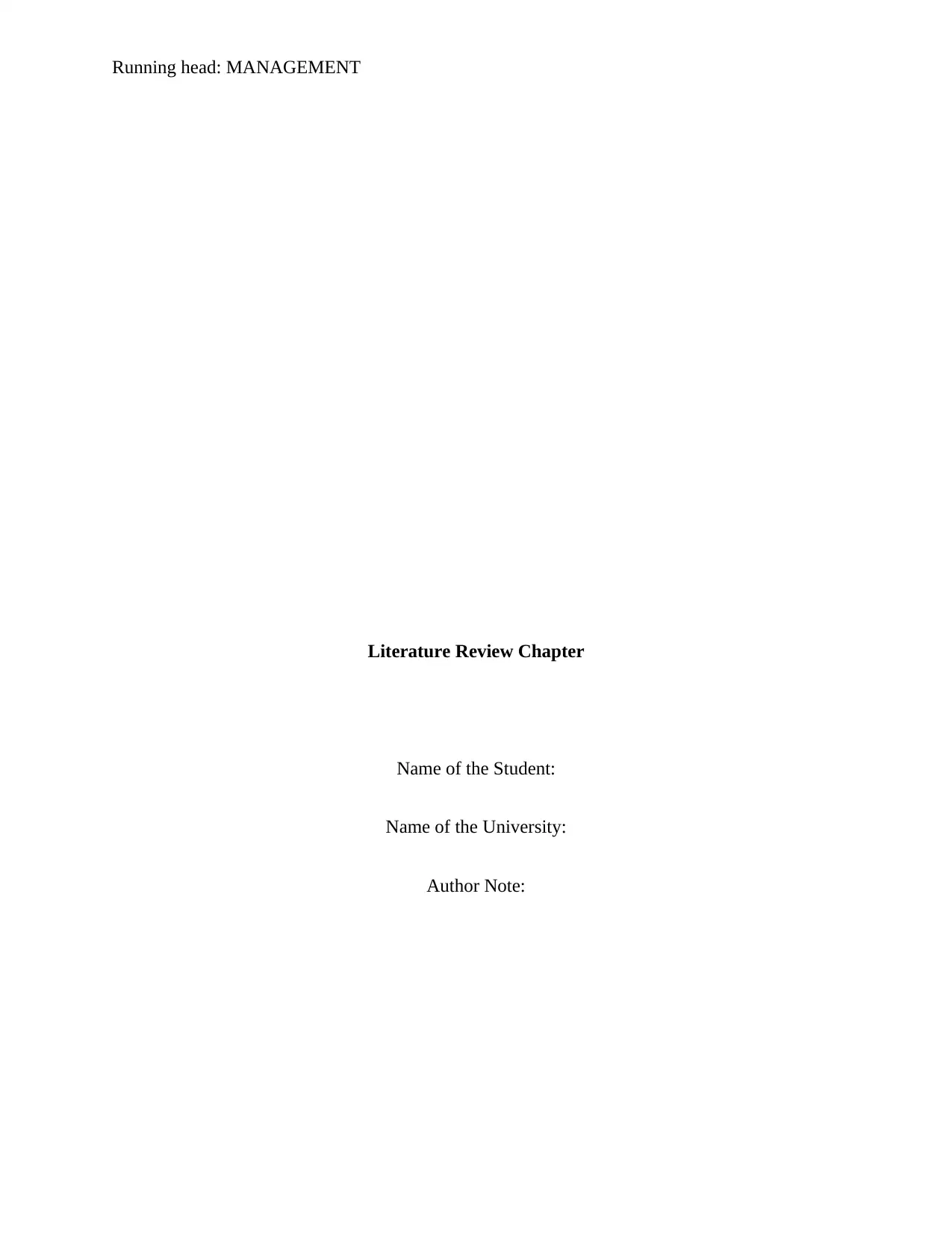
Running head: MANAGEMENT
Literature Review Chapter
Name of the Student:
Name of the University:
Author Note:
Literature Review Chapter
Name of the Student:
Name of the University:
Author Note:
Secure Best Marks with AI Grader
Need help grading? Try our AI Grader for instant feedback on your assignments.
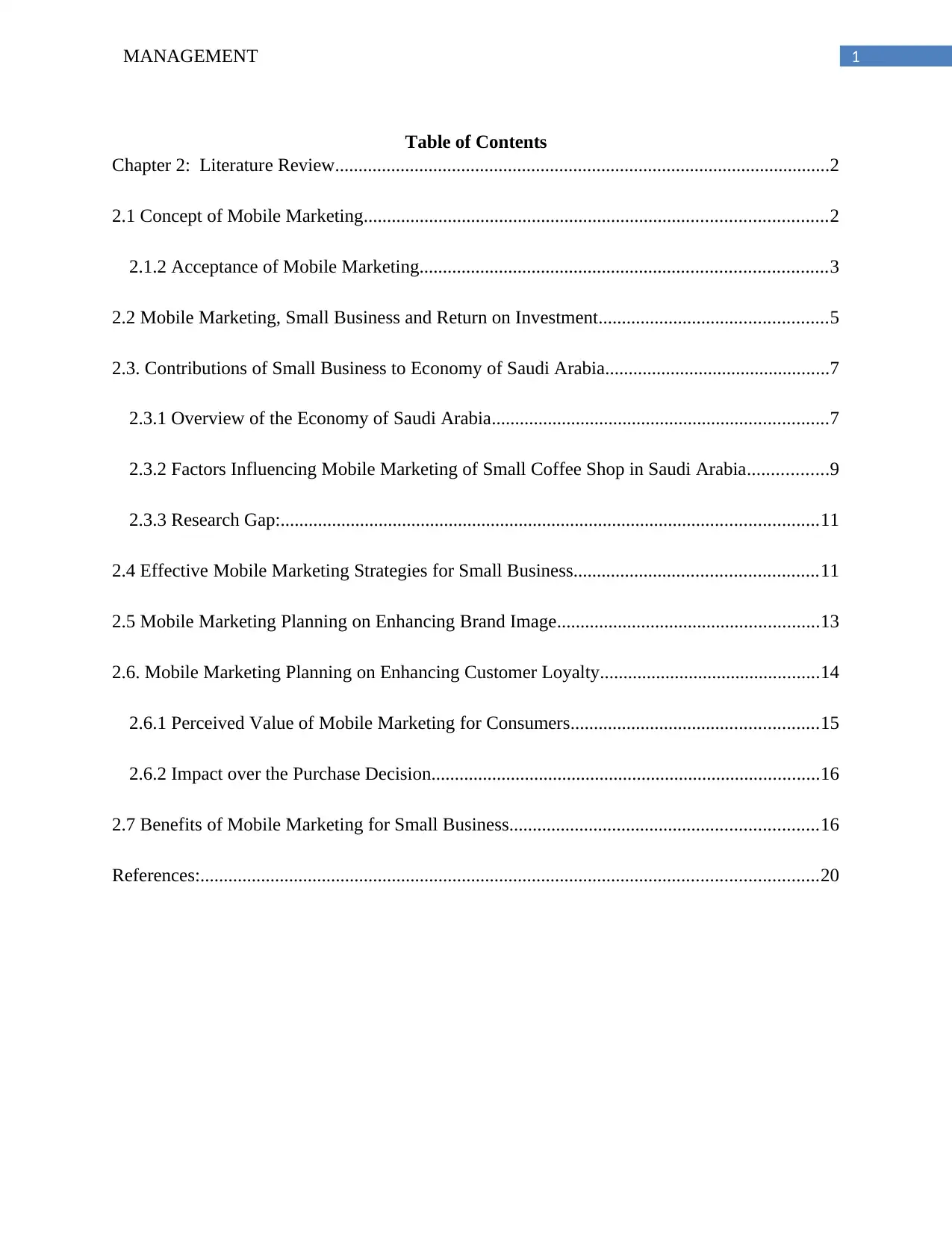
MANAGEMENT 1
Table of Contents
Chapter 2: Literature Review..........................................................................................................2
2.1 Concept of Mobile Marketing...................................................................................................2
2.1.2 Acceptance of Mobile Marketing.......................................................................................3
2.2 Mobile Marketing, Small Business and Return on Investment.................................................5
2.3. Contributions of Small Business to Economy of Saudi Arabia................................................7
2.3.1 Overview of the Economy of Saudi Arabia........................................................................7
2.3.2 Factors Influencing Mobile Marketing of Small Coffee Shop in Saudi Arabia.................9
2.3.3 Research Gap:...................................................................................................................11
2.4 Effective Mobile Marketing Strategies for Small Business....................................................11
2.5 Mobile Marketing Planning on Enhancing Brand Image........................................................13
2.6. Mobile Marketing Planning on Enhancing Customer Loyalty...............................................14
2.6.1 Perceived Value of Mobile Marketing for Consumers.....................................................15
2.6.2 Impact over the Purchase Decision...................................................................................16
2.7 Benefits of Mobile Marketing for Small Business..................................................................16
References:....................................................................................................................................20
Table of Contents
Chapter 2: Literature Review..........................................................................................................2
2.1 Concept of Mobile Marketing...................................................................................................2
2.1.2 Acceptance of Mobile Marketing.......................................................................................3
2.2 Mobile Marketing, Small Business and Return on Investment.................................................5
2.3. Contributions of Small Business to Economy of Saudi Arabia................................................7
2.3.1 Overview of the Economy of Saudi Arabia........................................................................7
2.3.2 Factors Influencing Mobile Marketing of Small Coffee Shop in Saudi Arabia.................9
2.3.3 Research Gap:...................................................................................................................11
2.4 Effective Mobile Marketing Strategies for Small Business....................................................11
2.5 Mobile Marketing Planning on Enhancing Brand Image........................................................13
2.6. Mobile Marketing Planning on Enhancing Customer Loyalty...............................................14
2.6.1 Perceived Value of Mobile Marketing for Consumers.....................................................15
2.6.2 Impact over the Purchase Decision...................................................................................16
2.7 Benefits of Mobile Marketing for Small Business..................................................................16
References:....................................................................................................................................20
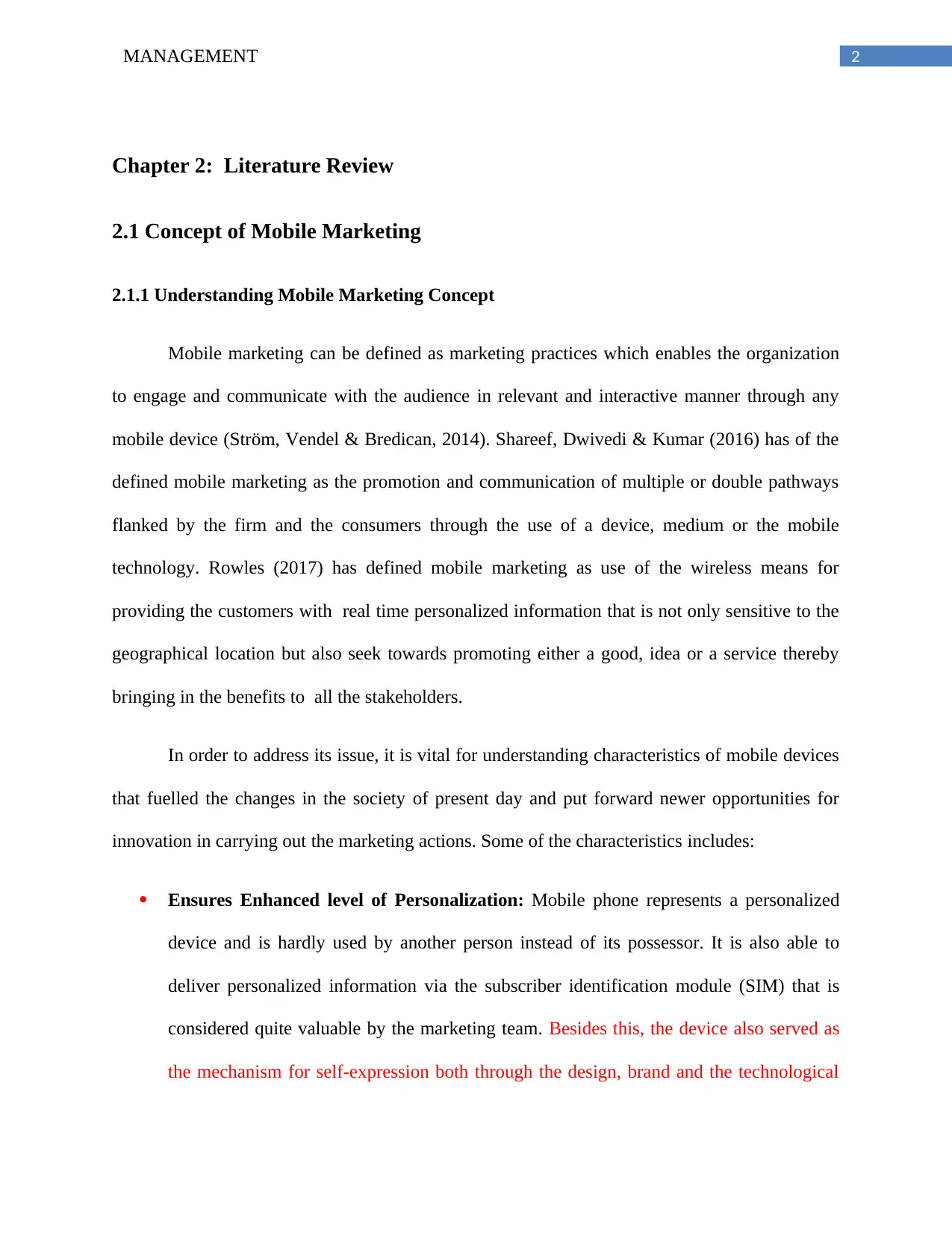
2MANAGEMENT
Chapter 2: Literature Review
2.1 Concept of Mobile Marketing
2.1.1 Understanding Mobile Marketing Concept
Mobile marketing can be defined as marketing practices which enables the organization
to engage and communicate with the audience in relevant and interactive manner through any
mobile device (Ström, Vendel & Bredican, 2014). Shareef, Dwivedi & Kumar (2016) has of the
defined mobile marketing as the promotion and communication of multiple or double pathways
flanked by the firm and the consumers through the use of a device, medium or the mobile
technology. Rowles (2017) has defined mobile marketing as use of the wireless means for
providing the customers with real time personalized information that is not only sensitive to the
geographical location but also seek towards promoting either a good, idea or a service thereby
bringing in the benefits to all the stakeholders.
In order to address its issue, it is vital for understanding characteristics of mobile devices
that fuelled the changes in the society of present day and put forward newer opportunities for
innovation in carrying out the marketing actions. Some of the characteristics includes:
Ensures Enhanced level of Personalization: Mobile phone represents a personalized
device and is hardly used by another person instead of its possessor. It is also able to
deliver personalized information via the subscriber identification module (SIM) that is
considered quite valuable by the marketing team. Besides this, the device also served as
the mechanism for self-expression both through the design, brand and the technological
Chapter 2: Literature Review
2.1 Concept of Mobile Marketing
2.1.1 Understanding Mobile Marketing Concept
Mobile marketing can be defined as marketing practices which enables the organization
to engage and communicate with the audience in relevant and interactive manner through any
mobile device (Ström, Vendel & Bredican, 2014). Shareef, Dwivedi & Kumar (2016) has of the
defined mobile marketing as the promotion and communication of multiple or double pathways
flanked by the firm and the consumers through the use of a device, medium or the mobile
technology. Rowles (2017) has defined mobile marketing as use of the wireless means for
providing the customers with real time personalized information that is not only sensitive to the
geographical location but also seek towards promoting either a good, idea or a service thereby
bringing in the benefits to all the stakeholders.
In order to address its issue, it is vital for understanding characteristics of mobile devices
that fuelled the changes in the society of present day and put forward newer opportunities for
innovation in carrying out the marketing actions. Some of the characteristics includes:
Ensures Enhanced level of Personalization: Mobile phone represents a personalized
device and is hardly used by another person instead of its possessor. It is also able to
deliver personalized information via the subscriber identification module (SIM) that is
considered quite valuable by the marketing team. Besides this, the device also served as
the mechanism for self-expression both through the design, brand and the technological

3MANAGEMENT
attributes as well as serve as an object of the appealing personalization through melodies
and tones chosen by users.
Ensures Omnipresence: It represents the ability of the users in receiving and carrying
out transactions irrespective of the place and the time. This ability has been made feasible
since the devices are always turned on as the users carry them everywhere.
Allows both way Communication: This acts as a crucial feature for application in the
marketing. The devices helps in establishing lifetime connectivity with the users (Pei &
Liang, 2013). This results in creating bigger opportunities for generating sensible
communication experience around the brands.
Ability to Identify Location: It comprises of an ability of identifying the geographical
location of a user's by tracking the location of the device. This feature is derived through
the integration of geographical localization of technologies commonly known as Global
Positioning System or GPS. This technology allows marketers to focus on location
specific marketing of the products or services.
2.1.2 Acceptance of Mobile Marketing
Some authors have claimed that consumers will express their consent on mobile
marketing provided they derive benefit from the advertising messages received. This can be
explained with the help of various theoretical models which are mentioned as follows:
Economic Information Model: It is based on communication backed up by the
theoretical basis for this particular assertion. The model considers consumers as active
organism who makes conscious decision on the advertising stimuli they want to perceive
and explore. The process of decision making process not only allows the user to
superimpose advertising perception on available activities along with selecting the format
attributes as well as serve as an object of the appealing personalization through melodies
and tones chosen by users.
Ensures Omnipresence: It represents the ability of the users in receiving and carrying
out transactions irrespective of the place and the time. This ability has been made feasible
since the devices are always turned on as the users carry them everywhere.
Allows both way Communication: This acts as a crucial feature for application in the
marketing. The devices helps in establishing lifetime connectivity with the users (Pei &
Liang, 2013). This results in creating bigger opportunities for generating sensible
communication experience around the brands.
Ability to Identify Location: It comprises of an ability of identifying the geographical
location of a user's by tracking the location of the device. This feature is derived through
the integration of geographical localization of technologies commonly known as Global
Positioning System or GPS. This technology allows marketers to focus on location
specific marketing of the products or services.
2.1.2 Acceptance of Mobile Marketing
Some authors have claimed that consumers will express their consent on mobile
marketing provided they derive benefit from the advertising messages received. This can be
explained with the help of various theoretical models which are mentioned as follows:
Economic Information Model: It is based on communication backed up by the
theoretical basis for this particular assertion. The model considers consumers as active
organism who makes conscious decision on the advertising stimuli they want to perceive
and explore. The process of decision making process not only allows the user to
superimpose advertising perception on available activities along with selecting the format
Secure Best Marks with AI Grader
Need help grading? Try our AI Grader for instant feedback on your assignments.

4MANAGEMENT
and type of advertising that they consider to be most useful. Time however acts as a key
constraint within the process of decision making (Leppäniemi & Karjaluoto, 2008)
Diffusion Innovation Model: It is the key theoretical model for analyzing relationship
amongst characteristics which made up innovation and rate of its adoption (Sugarhood et
al., 2014). According to this theory, whenever a particular concept is considered new, the
individual is found to use various communication tactics within the social system for
reaching a point that allows him to decide and understand whether to reject or adopt such
an innovation. The attributes or characteristics of the innovation has been found to
influence both decision of adoption by consumers and its speed of dissemination within
social group. In other words, this model puts forward suggestions which indicates that if
potential adopter indicates that positive perceptions with regard to combination of the
attributes that makes up the innovation there lies a higher probability of accepting or
adopting the innovation.
In regard to factors, which might impact the acceptance of the mobile advertising
amongst the consumers and researchers have discovered that the acceptance remain closely
associated with acceptance of the mobile device (Pelau & Zegreanu, 2010). A lot of studies on
the other hand, has searched for factors that associated the acceptance of advertising via Short
Service Messaging (SMS). It was found by Merisavo et al. (2007) that context and utility of a
content had noteworthy link of the advertising acceptance received via this medium. Other
studies has placed their focus on influence of a collection of inclinations, predispositions,
consumer attitudes and individual perceptions (Varnali & Toker, 2010). The additional
approaches that has helped in exploring the relationship amongst the demographic variable and
acceptance of the mobile marketing along with study of diffusion innovation in today’s society.
and type of advertising that they consider to be most useful. Time however acts as a key
constraint within the process of decision making (Leppäniemi & Karjaluoto, 2008)
Diffusion Innovation Model: It is the key theoretical model for analyzing relationship
amongst characteristics which made up innovation and rate of its adoption (Sugarhood et
al., 2014). According to this theory, whenever a particular concept is considered new, the
individual is found to use various communication tactics within the social system for
reaching a point that allows him to decide and understand whether to reject or adopt such
an innovation. The attributes or characteristics of the innovation has been found to
influence both decision of adoption by consumers and its speed of dissemination within
social group. In other words, this model puts forward suggestions which indicates that if
potential adopter indicates that positive perceptions with regard to combination of the
attributes that makes up the innovation there lies a higher probability of accepting or
adopting the innovation.
In regard to factors, which might impact the acceptance of the mobile advertising
amongst the consumers and researchers have discovered that the acceptance remain closely
associated with acceptance of the mobile device (Pelau & Zegreanu, 2010). A lot of studies on
the other hand, has searched for factors that associated the acceptance of advertising via Short
Service Messaging (SMS). It was found by Merisavo et al. (2007) that context and utility of a
content had noteworthy link of the advertising acceptance received via this medium. Other
studies has placed their focus on influence of a collection of inclinations, predispositions,
consumer attitudes and individual perceptions (Varnali & Toker, 2010). The additional
approaches that has helped in exploring the relationship amongst the demographic variable and
acceptance of the mobile marketing along with study of diffusion innovation in today’s society.
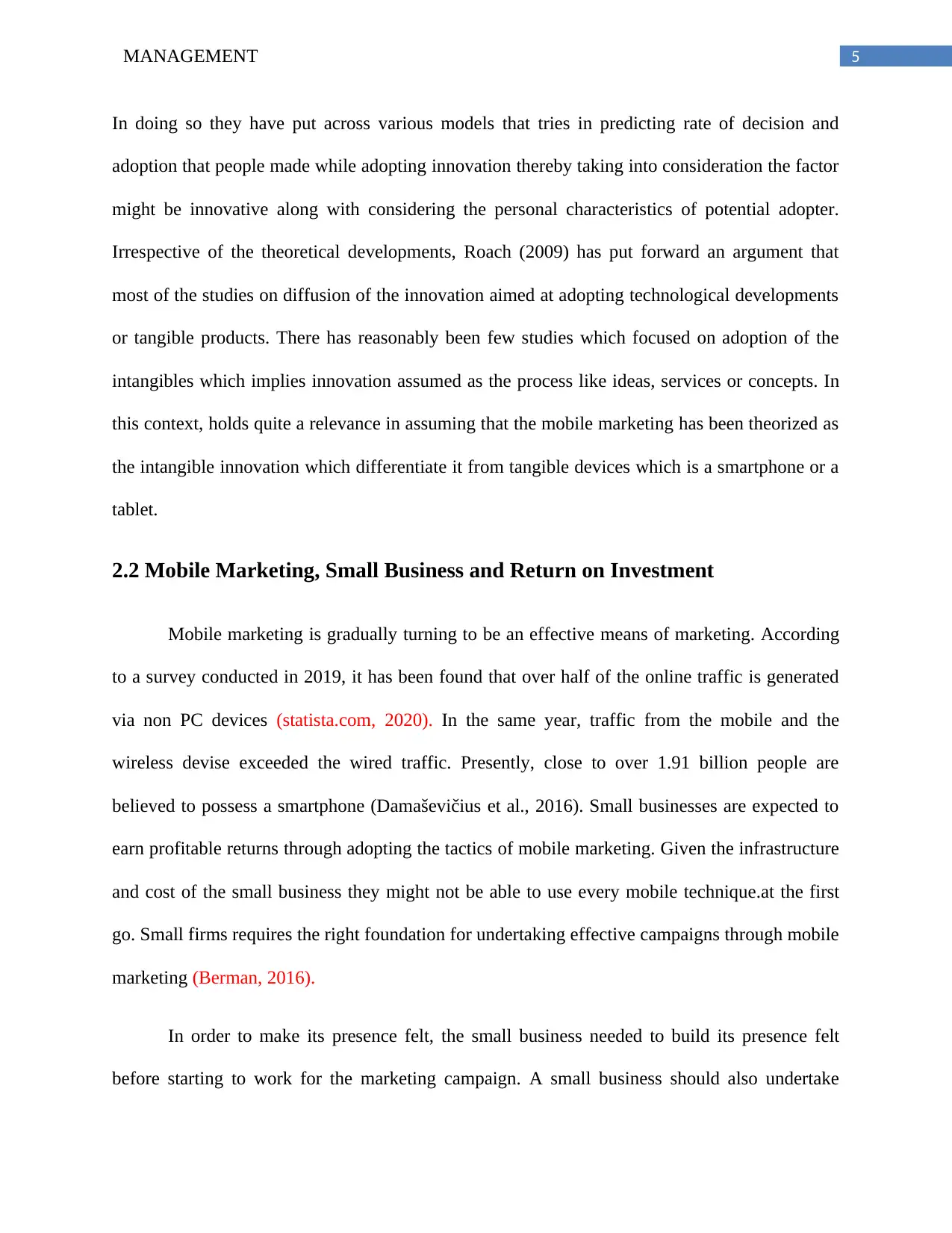
5MANAGEMENT
In doing so they have put across various models that tries in predicting rate of decision and
adoption that people made while adopting innovation thereby taking into consideration the factor
might be innovative along with considering the personal characteristics of potential adopter.
Irrespective of the theoretical developments, Roach (2009) has put forward an argument that
most of the studies on diffusion of the innovation aimed at adopting technological developments
or tangible products. There has reasonably been few studies which focused on adoption of the
intangibles which implies innovation assumed as the process like ideas, services or concepts. In
this context, holds quite a relevance in assuming that the mobile marketing has been theorized as
the intangible innovation which differentiate it from tangible devices which is a smartphone or a
tablet.
2.2 Mobile Marketing, Small Business and Return on Investment
Mobile marketing is gradually turning to be an effective means of marketing. According
to a survey conducted in 2019, it has been found that over half of the online traffic is generated
via non PC devices (statista.com, 2020). In the same year, traffic from the mobile and the
wireless devise exceeded the wired traffic. Presently, close to over 1.91 billion people are
believed to possess a smartphone (Damaševičius et al., 2016). Small businesses are expected to
earn profitable returns through adopting the tactics of mobile marketing. Given the infrastructure
and cost of the small business they might not be able to use every mobile technique.at the first
go. Small firms requires the right foundation for undertaking effective campaigns through mobile
marketing (Berman, 2016).
In order to make its presence felt, the small business needed to build its presence felt
before starting to work for the marketing campaign. A small business should also undertake
In doing so they have put across various models that tries in predicting rate of decision and
adoption that people made while adopting innovation thereby taking into consideration the factor
might be innovative along with considering the personal characteristics of potential adopter.
Irrespective of the theoretical developments, Roach (2009) has put forward an argument that
most of the studies on diffusion of the innovation aimed at adopting technological developments
or tangible products. There has reasonably been few studies which focused on adoption of the
intangibles which implies innovation assumed as the process like ideas, services or concepts. In
this context, holds quite a relevance in assuming that the mobile marketing has been theorized as
the intangible innovation which differentiate it from tangible devices which is a smartphone or a
tablet.
2.2 Mobile Marketing, Small Business and Return on Investment
Mobile marketing is gradually turning to be an effective means of marketing. According
to a survey conducted in 2019, it has been found that over half of the online traffic is generated
via non PC devices (statista.com, 2020). In the same year, traffic from the mobile and the
wireless devise exceeded the wired traffic. Presently, close to over 1.91 billion people are
believed to possess a smartphone (Damaševičius et al., 2016). Small businesses are expected to
earn profitable returns through adopting the tactics of mobile marketing. Given the infrastructure
and cost of the small business they might not be able to use every mobile technique.at the first
go. Small firms requires the right foundation for undertaking effective campaigns through mobile
marketing (Berman, 2016).
In order to make its presence felt, the small business needed to build its presence felt
before starting to work for the marketing campaign. A small business should also undertake

6MANAGEMENT
measures for either optimizing existing site or make its website mobile friendly. Web designers
nowadays makes use of responsive web designing techniques for creating website experience.
Above everything, a good mobile site must be easier to navigate. This is because people interact
with mobile sites differently than what they do from PC. Mobile websites must naturally
facilitate the mobile interactions of the users. For instance, clicking on the share button of social
media enables the users in opening specific app or going through a specific webpage.
Compared to the traditional marketing campaign, mobile marketing has been really found
to enhance the ability for creating a measurable Return on Investment (ROI) (Andrews et al.
2016). It is therefore important to ensure that the small business remains listed in the local
mobile searches like Google and Apple Maps. Registering in business directory services also
helps in improving the mobile presence. The cost associated with them is only investing a small
amount of time. Small business should steer the site visitors to proprietary app or an email or text
campaign. By simplifying the user experience with brand listings improves the mobile
conversion of small business without costly campaign.
Small business has been moving significant portion of the marketing efforts into mobile
arena. The buzz around the activities of mobile marketing has been the paid campaigns. It is
necessary for the small business to consider the benefits before it makes investment into the
highly priced tactics of mobile marketing. Some of these tactics includes (Lamberton & Stephen,
2016):
Geo-fencing: This tactic allows the small business to send a message to the mobile user
as soon as he enters a particular geographic area.
measures for either optimizing existing site or make its website mobile friendly. Web designers
nowadays makes use of responsive web designing techniques for creating website experience.
Above everything, a good mobile site must be easier to navigate. This is because people interact
with mobile sites differently than what they do from PC. Mobile websites must naturally
facilitate the mobile interactions of the users. For instance, clicking on the share button of social
media enables the users in opening specific app or going through a specific webpage.
Compared to the traditional marketing campaign, mobile marketing has been really found
to enhance the ability for creating a measurable Return on Investment (ROI) (Andrews et al.
2016). It is therefore important to ensure that the small business remains listed in the local
mobile searches like Google and Apple Maps. Registering in business directory services also
helps in improving the mobile presence. The cost associated with them is only investing a small
amount of time. Small business should steer the site visitors to proprietary app or an email or text
campaign. By simplifying the user experience with brand listings improves the mobile
conversion of small business without costly campaign.
Small business has been moving significant portion of the marketing efforts into mobile
arena. The buzz around the activities of mobile marketing has been the paid campaigns. It is
necessary for the small business to consider the benefits before it makes investment into the
highly priced tactics of mobile marketing. Some of these tactics includes (Lamberton & Stephen,
2016):
Geo-fencing: This tactic allows the small business to send a message to the mobile user
as soon as he enters a particular geographic area.
Paraphrase This Document
Need a fresh take? Get an instant paraphrase of this document with our AI Paraphraser

7MANAGEMENT
Targeting Third Party App: This allows small business with proprietary app may
undertake campaigns based on personal message targeting the smartphone users involved
in specific behavior.
Development of Proprietary App: These apps helps in selling, promoting and offering
fun distraction as long as the target market is provided with some value.
If carefully managed, the paid tactics might work and hence might require a higher level
of upfront investment along with a higher risk. Thus, the mobile marketing experience allowed
the consumers in connecting with the consumers thereby enhancing the brand value. A small
business is found to capitalize on the mobile marketing irrespective of the price range thereby
securing measurable return on investment.
2.3. Contributions of Small Business to Economy of Saudi Arabia
2.3.1 Overview of the Economy of Saudi Arabia
In terms of economic stature, Saudi Arabia has been the biggest oil exporters of the world
since the sector seems to contribute 45 percent of GDP (Niblock, 2015). The drop in oil prices on
a global scale had a massive impact on the economy of Saudi Arabia which forced it to diversify
its income sources through venturing in fields of trade, manufacturing and services.
Commercially, the country tried to develop its trade through the service trade during Haj
season in order to derive economic objectives besides providing the private sectors with
opportunities of adding value through privatization of various sectors of the government like
electricity, airlines, port services and telecommunications. Tourism sector is however expected to
raise its investment in domestic capital for development. The country’s financial sector has also
been found to implement latest infrastructure and the financial systems in major industrial
Targeting Third Party App: This allows small business with proprietary app may
undertake campaigns based on personal message targeting the smartphone users involved
in specific behavior.
Development of Proprietary App: These apps helps in selling, promoting and offering
fun distraction as long as the target market is provided with some value.
If carefully managed, the paid tactics might work and hence might require a higher level
of upfront investment along with a higher risk. Thus, the mobile marketing experience allowed
the consumers in connecting with the consumers thereby enhancing the brand value. A small
business is found to capitalize on the mobile marketing irrespective of the price range thereby
securing measurable return on investment.
2.3. Contributions of Small Business to Economy of Saudi Arabia
2.3.1 Overview of the Economy of Saudi Arabia
In terms of economic stature, Saudi Arabia has been the biggest oil exporters of the world
since the sector seems to contribute 45 percent of GDP (Niblock, 2015). The drop in oil prices on
a global scale had a massive impact on the economy of Saudi Arabia which forced it to diversify
its income sources through venturing in fields of trade, manufacturing and services.
Commercially, the country tried to develop its trade through the service trade during Haj
season in order to derive economic objectives besides providing the private sectors with
opportunities of adding value through privatization of various sectors of the government like
electricity, airlines, port services and telecommunications. Tourism sector is however expected to
raise its investment in domestic capital for development. The country’s financial sector has also
been found to implement latest infrastructure and the financial systems in major industrial
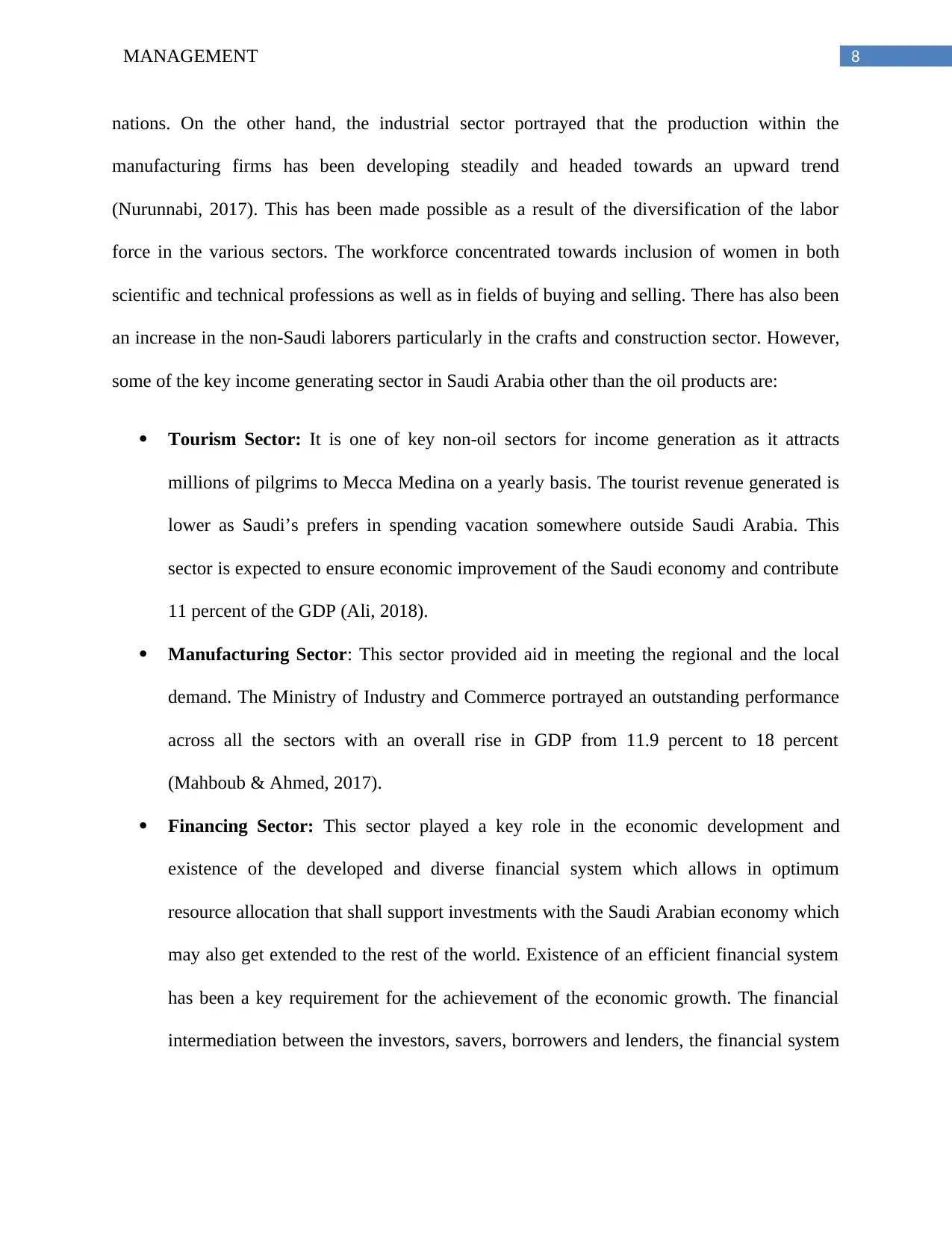
8MANAGEMENT
nations. On the other hand, the industrial sector portrayed that the production within the
manufacturing firms has been developing steadily and headed towards an upward trend
(Nurunnabi, 2017). This has been made possible as a result of the diversification of the labor
force in the various sectors. The workforce concentrated towards inclusion of women in both
scientific and technical professions as well as in fields of buying and selling. There has also been
an increase in the non-Saudi laborers particularly in the crafts and construction sector. However,
some of the key income generating sector in Saudi Arabia other than the oil products are:
Tourism Sector: It is one of key non-oil sectors for income generation as it attracts
millions of pilgrims to Mecca Medina on a yearly basis. The tourist revenue generated is
lower as Saudi’s prefers in spending vacation somewhere outside Saudi Arabia. This
sector is expected to ensure economic improvement of the Saudi economy and contribute
11 percent of the GDP (Ali, 2018).
Manufacturing Sector: This sector provided aid in meeting the regional and the local
demand. The Ministry of Industry and Commerce portrayed an outstanding performance
across all the sectors with an overall rise in GDP from 11.9 percent to 18 percent
(Mahboub & Ahmed, 2017).
Financing Sector: This sector played a key role in the economic development and
existence of the developed and diverse financial system which allows in optimum
resource allocation that shall support investments with the Saudi Arabian economy which
may also get extended to the rest of the world. Existence of an efficient financial system
has been a key requirement for the achievement of the economic growth. The financial
intermediation between the investors, savers, borrowers and lenders, the financial system
nations. On the other hand, the industrial sector portrayed that the production within the
manufacturing firms has been developing steadily and headed towards an upward trend
(Nurunnabi, 2017). This has been made possible as a result of the diversification of the labor
force in the various sectors. The workforce concentrated towards inclusion of women in both
scientific and technical professions as well as in fields of buying and selling. There has also been
an increase in the non-Saudi laborers particularly in the crafts and construction sector. However,
some of the key income generating sector in Saudi Arabia other than the oil products are:
Tourism Sector: It is one of key non-oil sectors for income generation as it attracts
millions of pilgrims to Mecca Medina on a yearly basis. The tourist revenue generated is
lower as Saudi’s prefers in spending vacation somewhere outside Saudi Arabia. This
sector is expected to ensure economic improvement of the Saudi economy and contribute
11 percent of the GDP (Ali, 2018).
Manufacturing Sector: This sector provided aid in meeting the regional and the local
demand. The Ministry of Industry and Commerce portrayed an outstanding performance
across all the sectors with an overall rise in GDP from 11.9 percent to 18 percent
(Mahboub & Ahmed, 2017).
Financing Sector: This sector played a key role in the economic development and
existence of the developed and diverse financial system which allows in optimum
resource allocation that shall support investments with the Saudi Arabian economy which
may also get extended to the rest of the world. Existence of an efficient financial system
has been a key requirement for the achievement of the economic growth. The financial
intermediation between the investors, savers, borrowers and lenders, the financial system

9MANAGEMENT
encouraged investment, savings and also urged optimal routing of the available funds for
investment (Almalki & Batayneh, 2015).
Private Sector: The government of Saudi Arabia followed development strategy towards
the private sector by supporting the giant projects as a means of diversifying income.
This provided encouragement to business to undertake investment in Saudi Arabia along
with formation of huge national entities. Besides, the government also provided support
where citizens faced difficulty in establishing industries in Saudi Arabia thereby
enhancing the chance of acquiring increased level of profit (Jehanzeb, Rasheed &
Rasheed, 2013).
Nevertheless, as per records of Ministry of the Trade and Investment, the commercial
records for café activity during the year 2018 rose by 21 percent in comparison to that of 2017.
The recorded number of cafés rose from 5152 in 2017 to 6272 in 2018 (aleqt.com, 2019). As a
result some business people shifted towards making more investment in coffee shop business as
it seemed quite lucrative.
2.3.2 Factors Influencing Mobile Marketing of Small Coffee Shop in Saudi Arabia
As suggested by Makki & Chang (2015), mobile marketing represent activities
accomplished by the mobile devices of consumers via internet connectivity. The Mobile
Marketing Association has defined mobile marketing as a vital strategy where the businesses
implements advertisements via the mobile channels for reaching target audience. Mobile
marketing reaches the target customers faster than the traditional marketing due to its ability of
accessing the customers (Hopkins and Turner 2012). One of the key trait of mobile marketing
has been its effectiveness and measurability in raising the brand awareness amongst the
encouraged investment, savings and also urged optimal routing of the available funds for
investment (Almalki & Batayneh, 2015).
Private Sector: The government of Saudi Arabia followed development strategy towards
the private sector by supporting the giant projects as a means of diversifying income.
This provided encouragement to business to undertake investment in Saudi Arabia along
with formation of huge national entities. Besides, the government also provided support
where citizens faced difficulty in establishing industries in Saudi Arabia thereby
enhancing the chance of acquiring increased level of profit (Jehanzeb, Rasheed &
Rasheed, 2013).
Nevertheless, as per records of Ministry of the Trade and Investment, the commercial
records for café activity during the year 2018 rose by 21 percent in comparison to that of 2017.
The recorded number of cafés rose from 5152 in 2017 to 6272 in 2018 (aleqt.com, 2019). As a
result some business people shifted towards making more investment in coffee shop business as
it seemed quite lucrative.
2.3.2 Factors Influencing Mobile Marketing of Small Coffee Shop in Saudi Arabia
As suggested by Makki & Chang (2015), mobile marketing represent activities
accomplished by the mobile devices of consumers via internet connectivity. The Mobile
Marketing Association has defined mobile marketing as a vital strategy where the businesses
implements advertisements via the mobile channels for reaching target audience. Mobile
marketing reaches the target customers faster than the traditional marketing due to its ability of
accessing the customers (Hopkins and Turner 2012). One of the key trait of mobile marketing
has been its effectiveness and measurability in raising the brand awareness amongst the
Secure Best Marks with AI Grader
Need help grading? Try our AI Grader for instant feedback on your assignments.
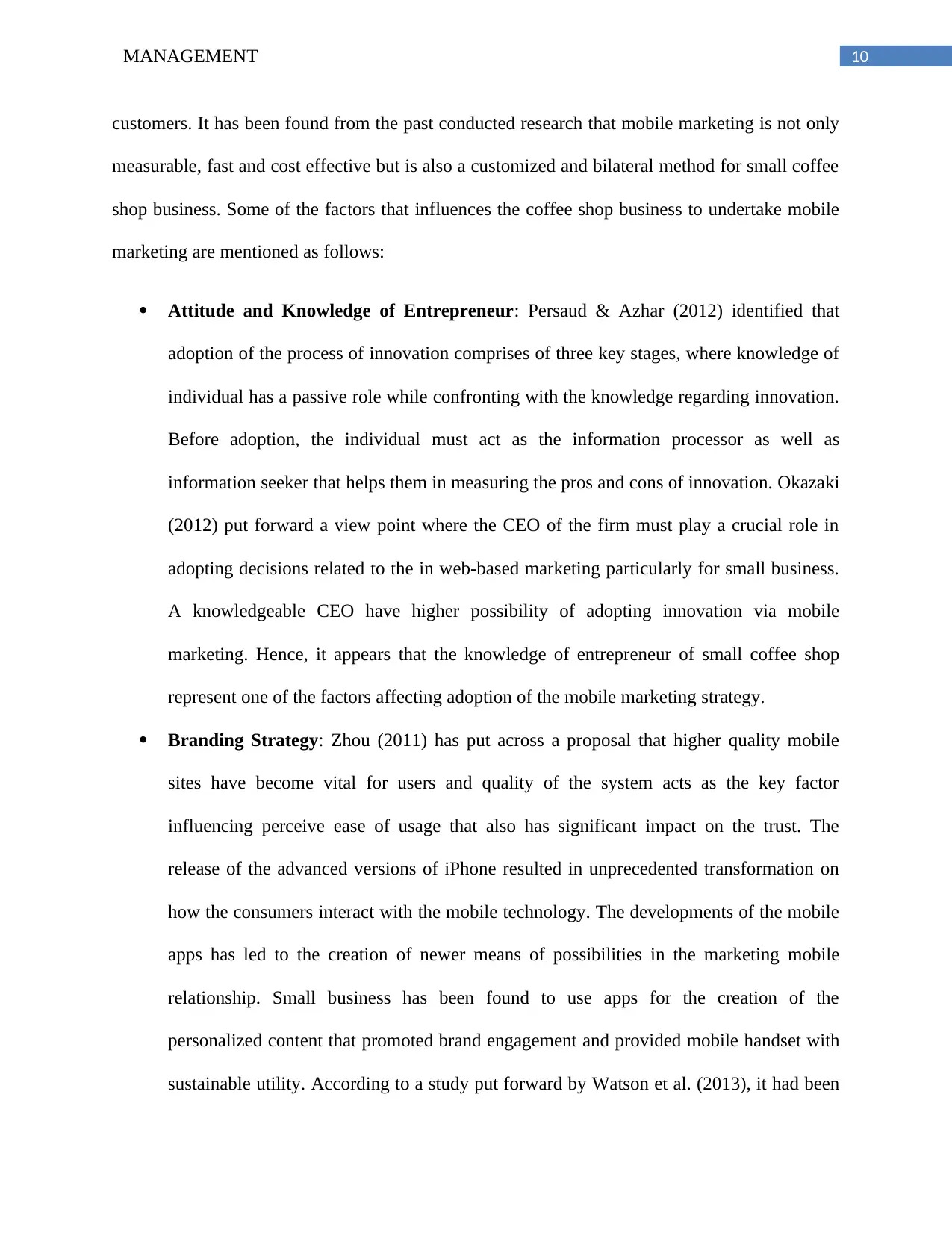
10MANAGEMENT
customers. It has been found from the past conducted research that mobile marketing is not only
measurable, fast and cost effective but is also a customized and bilateral method for small coffee
shop business. Some of the factors that influences the coffee shop business to undertake mobile
marketing are mentioned as follows:
Attitude and Knowledge of Entrepreneur: Persaud & Azhar (2012) identified that
adoption of the process of innovation comprises of three key stages, where knowledge of
individual has a passive role while confronting with the knowledge regarding innovation.
Before adoption, the individual must act as the information processor as well as
information seeker that helps them in measuring the pros and cons of innovation. Okazaki
(2012) put forward a view point where the CEO of the firm must play a crucial role in
adopting decisions related to the in web-based marketing particularly for small business.
A knowledgeable CEO have higher possibility of adopting innovation via mobile
marketing. Hence, it appears that the knowledge of entrepreneur of small coffee shop
represent one of the factors affecting adoption of the mobile marketing strategy.
Branding Strategy: Zhou (2011) has put across a proposal that higher quality mobile
sites have become vital for users and quality of the system acts as the key factor
influencing perceive ease of usage that also has significant impact on the trust. The
release of the advanced versions of iPhone resulted in unprecedented transformation on
how the consumers interact with the mobile technology. The developments of the mobile
apps has led to the creation of newer means of possibilities in the marketing mobile
relationship. Small business has been found to use apps for the creation of the
personalized content that promoted brand engagement and provided mobile handset with
sustainable utility. According to a study put forward by Watson et al. (2013), it had been
customers. It has been found from the past conducted research that mobile marketing is not only
measurable, fast and cost effective but is also a customized and bilateral method for small coffee
shop business. Some of the factors that influences the coffee shop business to undertake mobile
marketing are mentioned as follows:
Attitude and Knowledge of Entrepreneur: Persaud & Azhar (2012) identified that
adoption of the process of innovation comprises of three key stages, where knowledge of
individual has a passive role while confronting with the knowledge regarding innovation.
Before adoption, the individual must act as the information processor as well as
information seeker that helps them in measuring the pros and cons of innovation. Okazaki
(2012) put forward a view point where the CEO of the firm must play a crucial role in
adopting decisions related to the in web-based marketing particularly for small business.
A knowledgeable CEO have higher possibility of adopting innovation via mobile
marketing. Hence, it appears that the knowledge of entrepreneur of small coffee shop
represent one of the factors affecting adoption of the mobile marketing strategy.
Branding Strategy: Zhou (2011) has put across a proposal that higher quality mobile
sites have become vital for users and quality of the system acts as the key factor
influencing perceive ease of usage that also has significant impact on the trust. The
release of the advanced versions of iPhone resulted in unprecedented transformation on
how the consumers interact with the mobile technology. The developments of the mobile
apps has led to the creation of newer means of possibilities in the marketing mobile
relationship. Small business has been found to use apps for the creation of the
personalized content that promoted brand engagement and provided mobile handset with
sustainable utility. According to a study put forward by Watson et al. (2013), it had been
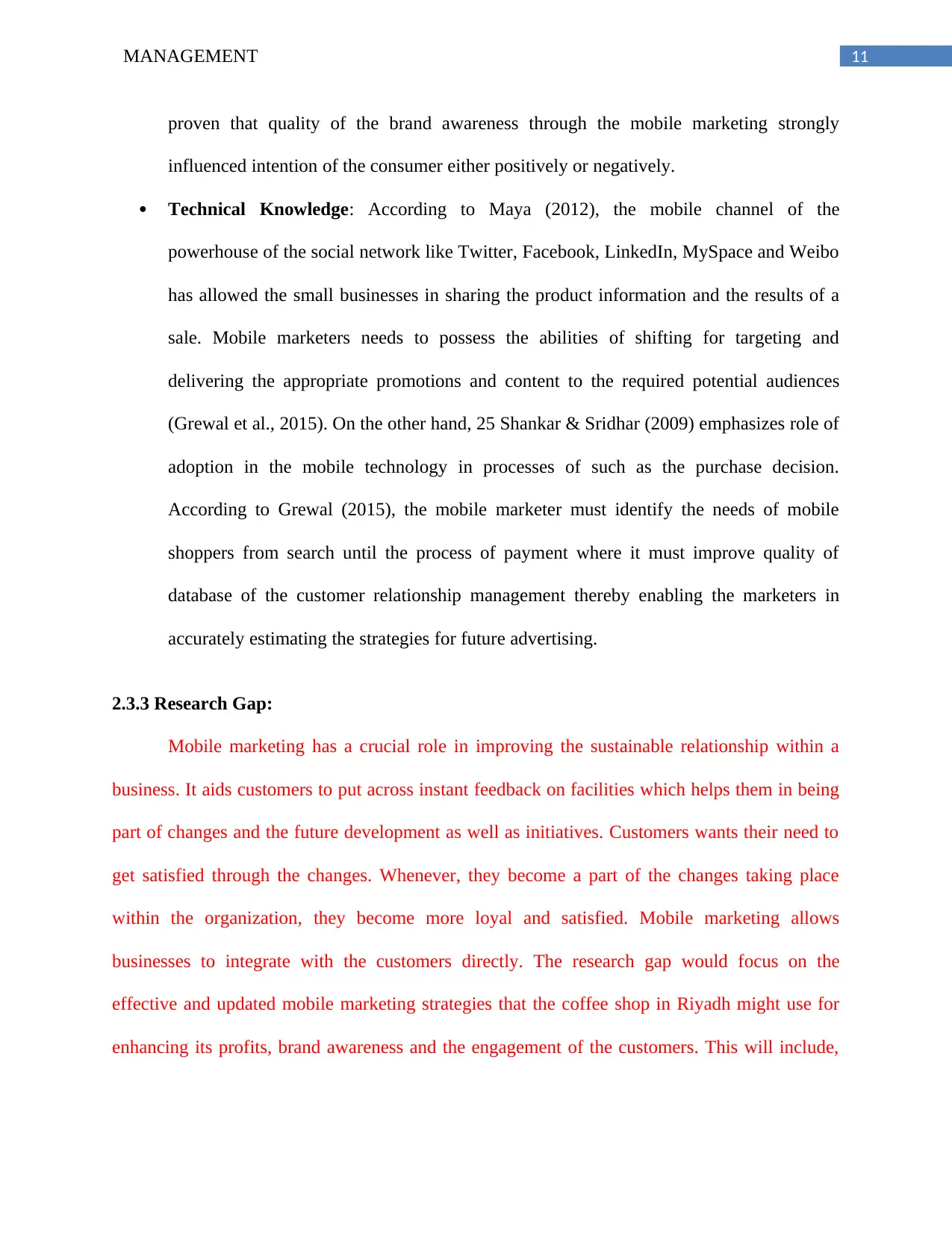
11MANAGEMENT
proven that quality of the brand awareness through the mobile marketing strongly
influenced intention of the consumer either positively or negatively.
Technical Knowledge: According to Maya (2012), the mobile channel of the
powerhouse of the social network like Twitter, Facebook, LinkedIn, MySpace and Weibo
has allowed the small businesses in sharing the product information and the results of a
sale. Mobile marketers needs to possess the abilities of shifting for targeting and
delivering the appropriate promotions and content to the required potential audiences
(Grewal et al., 2015). On the other hand, 25 Shankar & Sridhar (2009) emphasizes role of
adoption in the mobile technology in processes of such as the purchase decision.
According to Grewal (2015), the mobile marketer must identify the needs of mobile
shoppers from search until the process of payment where it must improve quality of
database of the customer relationship management thereby enabling the marketers in
accurately estimating the strategies for future advertising.
2.3.3 Research Gap:
Mobile marketing has a crucial role in improving the sustainable relationship within a
business. It aids customers to put across instant feedback on facilities which helps them in being
part of changes and the future development as well as initiatives. Customers wants their need to
get satisfied through the changes. Whenever, they become a part of the changes taking place
within the organization, they become more loyal and satisfied. Mobile marketing allows
businesses to integrate with the customers directly. The research gap would focus on the
effective and updated mobile marketing strategies that the coffee shop in Riyadh might use for
enhancing its profits, brand awareness and the engagement of the customers. This will include,
proven that quality of the brand awareness through the mobile marketing strongly
influenced intention of the consumer either positively or negatively.
Technical Knowledge: According to Maya (2012), the mobile channel of the
powerhouse of the social network like Twitter, Facebook, LinkedIn, MySpace and Weibo
has allowed the small businesses in sharing the product information and the results of a
sale. Mobile marketers needs to possess the abilities of shifting for targeting and
delivering the appropriate promotions and content to the required potential audiences
(Grewal et al., 2015). On the other hand, 25 Shankar & Sridhar (2009) emphasizes role of
adoption in the mobile technology in processes of such as the purchase decision.
According to Grewal (2015), the mobile marketer must identify the needs of mobile
shoppers from search until the process of payment where it must improve quality of
database of the customer relationship management thereby enabling the marketers in
accurately estimating the strategies for future advertising.
2.3.3 Research Gap:
Mobile marketing has a crucial role in improving the sustainable relationship within a
business. It aids customers to put across instant feedback on facilities which helps them in being
part of changes and the future development as well as initiatives. Customers wants their need to
get satisfied through the changes. Whenever, they become a part of the changes taking place
within the organization, they become more loyal and satisfied. Mobile marketing allows
businesses to integrate with the customers directly. The research gap would focus on the
effective and updated mobile marketing strategies that the coffee shop in Riyadh might use for
enhancing its profits, brand awareness and the engagement of the customers. This will include,
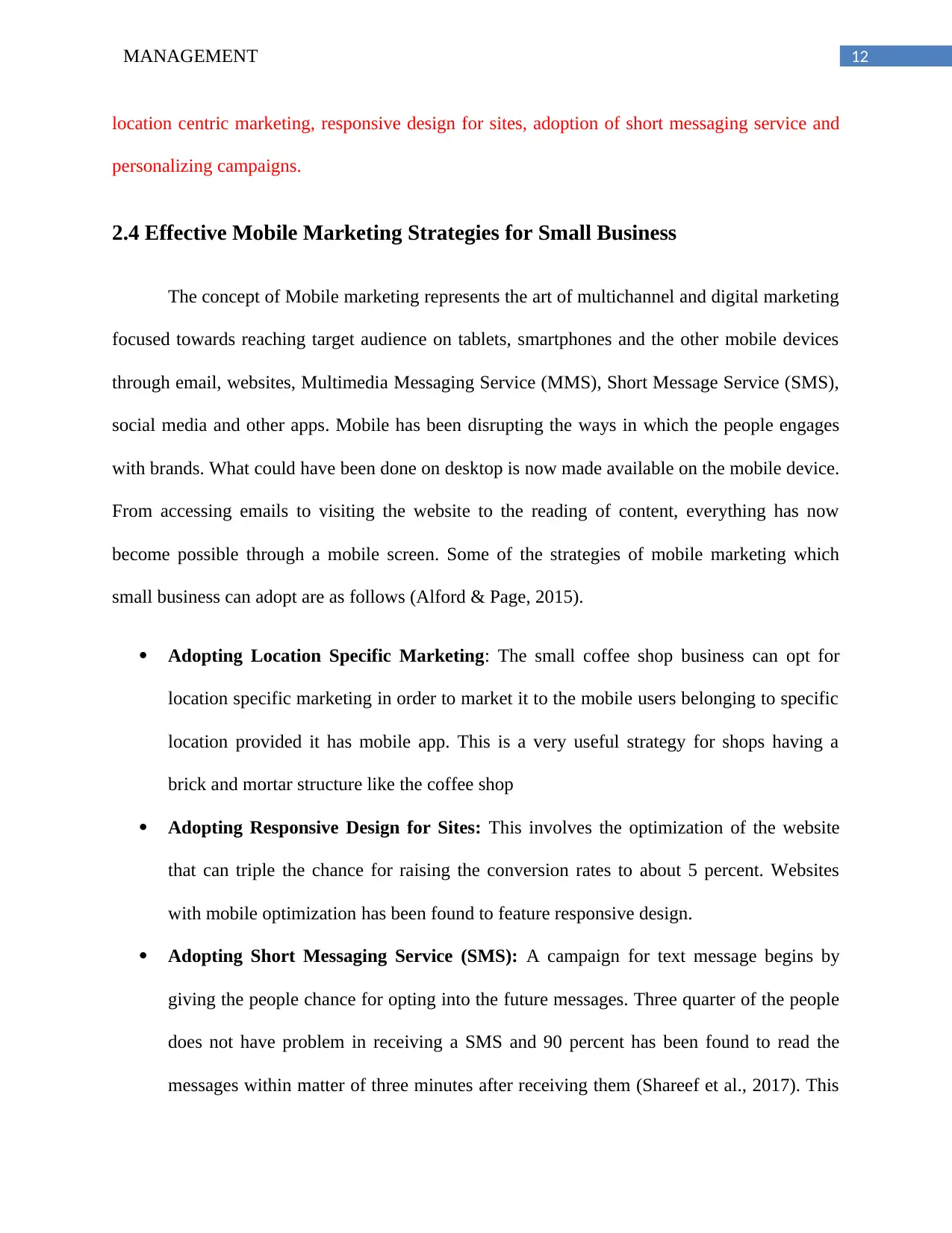
12MANAGEMENT
location centric marketing, responsive design for sites, adoption of short messaging service and
personalizing campaigns.
2.4 Effective Mobile Marketing Strategies for Small Business
The concept of Mobile marketing represents the art of multichannel and digital marketing
focused towards reaching target audience on tablets, smartphones and the other mobile devices
through email, websites, Multimedia Messaging Service (MMS), Short Message Service (SMS),
social media and other apps. Mobile has been disrupting the ways in which the people engages
with brands. What could have been done on desktop is now made available on the mobile device.
From accessing emails to visiting the website to the reading of content, everything has now
become possible through a mobile screen. Some of the strategies of mobile marketing which
small business can adopt are as follows (Alford & Page, 2015).
Adopting Location Specific Marketing: The small coffee shop business can opt for
location specific marketing in order to market it to the mobile users belonging to specific
location provided it has mobile app. This is a very useful strategy for shops having a
brick and mortar structure like the coffee shop
Adopting Responsive Design for Sites: This involves the optimization of the website
that can triple the chance for raising the conversion rates to about 5 percent. Websites
with mobile optimization has been found to feature responsive design.
Adopting Short Messaging Service (SMS): A campaign for text message begins by
giving the people chance for opting into the future messages. Three quarter of the people
does not have problem in receiving a SMS and 90 percent has been found to read the
messages within matter of three minutes after receiving them (Shareef et al., 2017). This
location centric marketing, responsive design for sites, adoption of short messaging service and
personalizing campaigns.
2.4 Effective Mobile Marketing Strategies for Small Business
The concept of Mobile marketing represents the art of multichannel and digital marketing
focused towards reaching target audience on tablets, smartphones and the other mobile devices
through email, websites, Multimedia Messaging Service (MMS), Short Message Service (SMS),
social media and other apps. Mobile has been disrupting the ways in which the people engages
with brands. What could have been done on desktop is now made available on the mobile device.
From accessing emails to visiting the website to the reading of content, everything has now
become possible through a mobile screen. Some of the strategies of mobile marketing which
small business can adopt are as follows (Alford & Page, 2015).
Adopting Location Specific Marketing: The small coffee shop business can opt for
location specific marketing in order to market it to the mobile users belonging to specific
location provided it has mobile app. This is a very useful strategy for shops having a
brick and mortar structure like the coffee shop
Adopting Responsive Design for Sites: This involves the optimization of the website
that can triple the chance for raising the conversion rates to about 5 percent. Websites
with mobile optimization has been found to feature responsive design.
Adopting Short Messaging Service (SMS): A campaign for text message begins by
giving the people chance for opting into the future messages. Three quarter of the people
does not have problem in receiving a SMS and 90 percent has been found to read the
messages within matter of three minutes after receiving them (Shareef et al., 2017). This
Paraphrase This Document
Need a fresh take? Get an instant paraphrase of this document with our AI Paraphraser
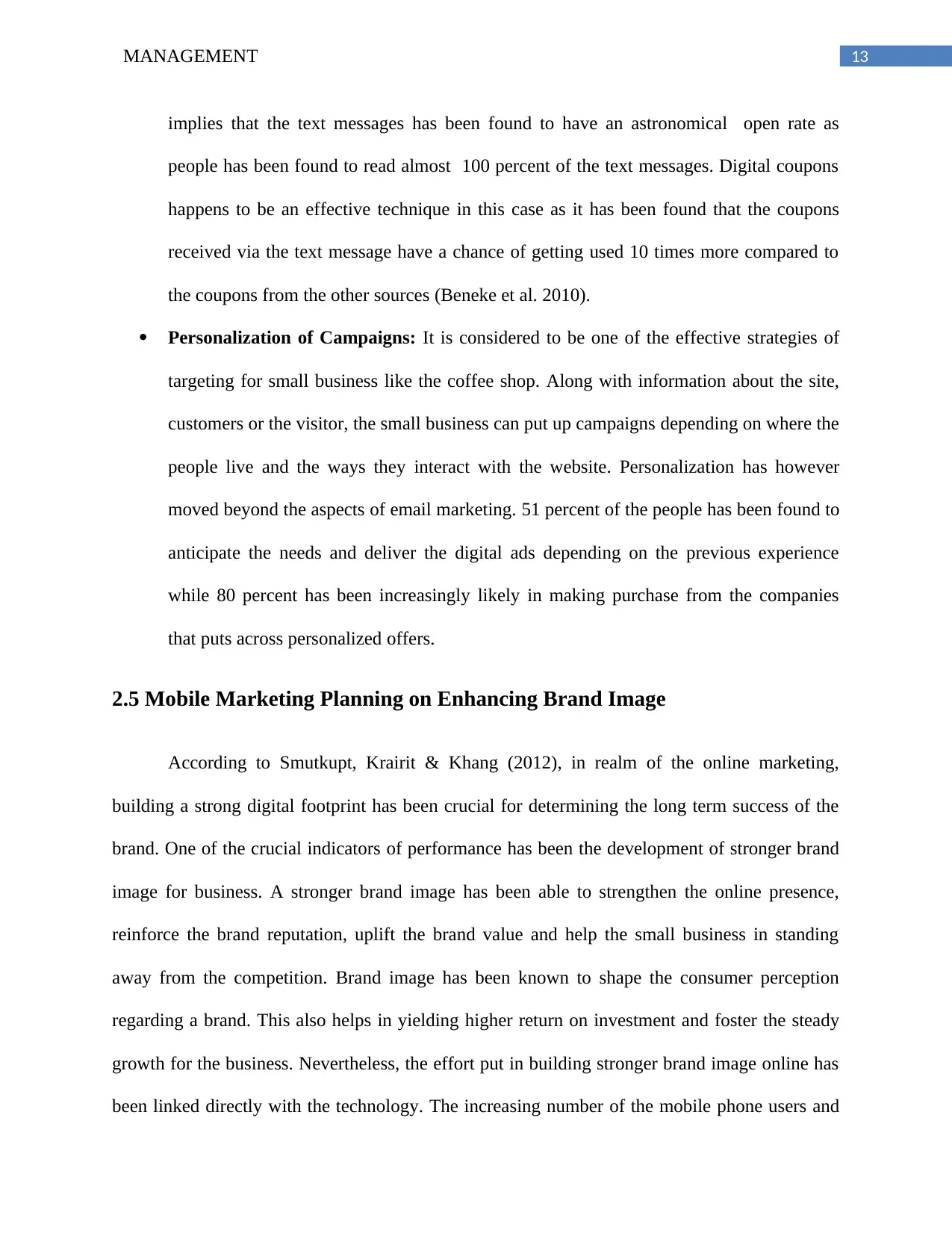
13MANAGEMENT
implies that the text messages has been found to have an astronomical open rate as
people has been found to read almost 100 percent of the text messages. Digital coupons
happens to be an effective technique in this case as it has been found that the coupons
received via the text message have a chance of getting used 10 times more compared to
the coupons from the other sources (Beneke et al. 2010).
Personalization of Campaigns: It is considered to be one of the effective strategies of
targeting for small business like the coffee shop. Along with information about the site,
customers or the visitor, the small business can put up campaigns depending on where the
people live and the ways they interact with the website. Personalization has however
moved beyond the aspects of email marketing. 51 percent of the people has been found to
anticipate the needs and deliver the digital ads depending on the previous experience
while 80 percent has been increasingly likely in making purchase from the companies
that puts across personalized offers.
2.5 Mobile Marketing Planning on Enhancing Brand Image
According to Smutkupt, Krairit & Khang (2012), in realm of the online marketing,
building a strong digital footprint has been crucial for determining the long term success of the
brand. One of the crucial indicators of performance has been the development of stronger brand
image for business. A stronger brand image has been able to strengthen the online presence,
reinforce the brand reputation, uplift the brand value and help the small business in standing
away from the competition. Brand image has been known to shape the consumer perception
regarding a brand. This also helps in yielding higher return on investment and foster the steady
growth for the business. Nevertheless, the effort put in building stronger brand image online has
been linked directly with the technology. The increasing number of the mobile phone users and
implies that the text messages has been found to have an astronomical open rate as
people has been found to read almost 100 percent of the text messages. Digital coupons
happens to be an effective technique in this case as it has been found that the coupons
received via the text message have a chance of getting used 10 times more compared to
the coupons from the other sources (Beneke et al. 2010).
Personalization of Campaigns: It is considered to be one of the effective strategies of
targeting for small business like the coffee shop. Along with information about the site,
customers or the visitor, the small business can put up campaigns depending on where the
people live and the ways they interact with the website. Personalization has however
moved beyond the aspects of email marketing. 51 percent of the people has been found to
anticipate the needs and deliver the digital ads depending on the previous experience
while 80 percent has been increasingly likely in making purchase from the companies
that puts across personalized offers.
2.5 Mobile Marketing Planning on Enhancing Brand Image
According to Smutkupt, Krairit & Khang (2012), in realm of the online marketing,
building a strong digital footprint has been crucial for determining the long term success of the
brand. One of the crucial indicators of performance has been the development of stronger brand
image for business. A stronger brand image has been able to strengthen the online presence,
reinforce the brand reputation, uplift the brand value and help the small business in standing
away from the competition. Brand image has been known to shape the consumer perception
regarding a brand. This also helps in yielding higher return on investment and foster the steady
growth for the business. Nevertheless, the effort put in building stronger brand image online has
been linked directly with the technology. The increasing number of the mobile phone users and

14MANAGEMENT
the ample number of the smartphone brands has contributed to the surge in competition of the
mobile internet. According to reports, the penetration rate of the mobile internet has reached
closer to 63.4 percent and has been expected to rise further (Bouhlel et al., 2011). The mobile
marketing presence acts as the key determinant on how the brand remains perceived amongst the
online users. The plan for mobile marketing has been able to enhance the brand image due to the
following reasons (Varshney & Joy, 2015)
The presence of the response design allowed the websites to remain fitted on the small
screens of the respective mobile devices. Whenever the user access the website of the
brand through the tablet or the smartphone, the responsive design enables it to get
reformatted as per the dimension of the screen thereby putting across comfortable
browsing experience for the user. This kind of design provides the brand with better shot
in displaying the key components that includes images, logo, color and typography.
The use of the social media network also act as the excellent platform in posting the
attractive content, getting engaged with the customers and ensure lead generation. The
social media also aids the small business in posting compelling product images, captions,
info graphics, stories and videos for conveying the brand message. Accessibility of the
social media on the mobile has enabled the brands in supplementing the brand identity
with the innovative features like contest, polls, reviews and different forms of strategies
for brand engagement.
The mobile responsive content which the brands adopt enables in building a brand image
amongst the mobile users. The attractive and relevant content used by brand makes it
popular in the search query (Ashley & Tuten, 2015)
2.6. Mobile Marketing Planning on Enhancing Customer Loyalty
the ample number of the smartphone brands has contributed to the surge in competition of the
mobile internet. According to reports, the penetration rate of the mobile internet has reached
closer to 63.4 percent and has been expected to rise further (Bouhlel et al., 2011). The mobile
marketing presence acts as the key determinant on how the brand remains perceived amongst the
online users. The plan for mobile marketing has been able to enhance the brand image due to the
following reasons (Varshney & Joy, 2015)
The presence of the response design allowed the websites to remain fitted on the small
screens of the respective mobile devices. Whenever the user access the website of the
brand through the tablet or the smartphone, the responsive design enables it to get
reformatted as per the dimension of the screen thereby putting across comfortable
browsing experience for the user. This kind of design provides the brand with better shot
in displaying the key components that includes images, logo, color and typography.
The use of the social media network also act as the excellent platform in posting the
attractive content, getting engaged with the customers and ensure lead generation. The
social media also aids the small business in posting compelling product images, captions,
info graphics, stories and videos for conveying the brand message. Accessibility of the
social media on the mobile has enabled the brands in supplementing the brand identity
with the innovative features like contest, polls, reviews and different forms of strategies
for brand engagement.
The mobile responsive content which the brands adopt enables in building a brand image
amongst the mobile users. The attractive and relevant content used by brand makes it
popular in the search query (Ashley & Tuten, 2015)
2.6. Mobile Marketing Planning on Enhancing Customer Loyalty
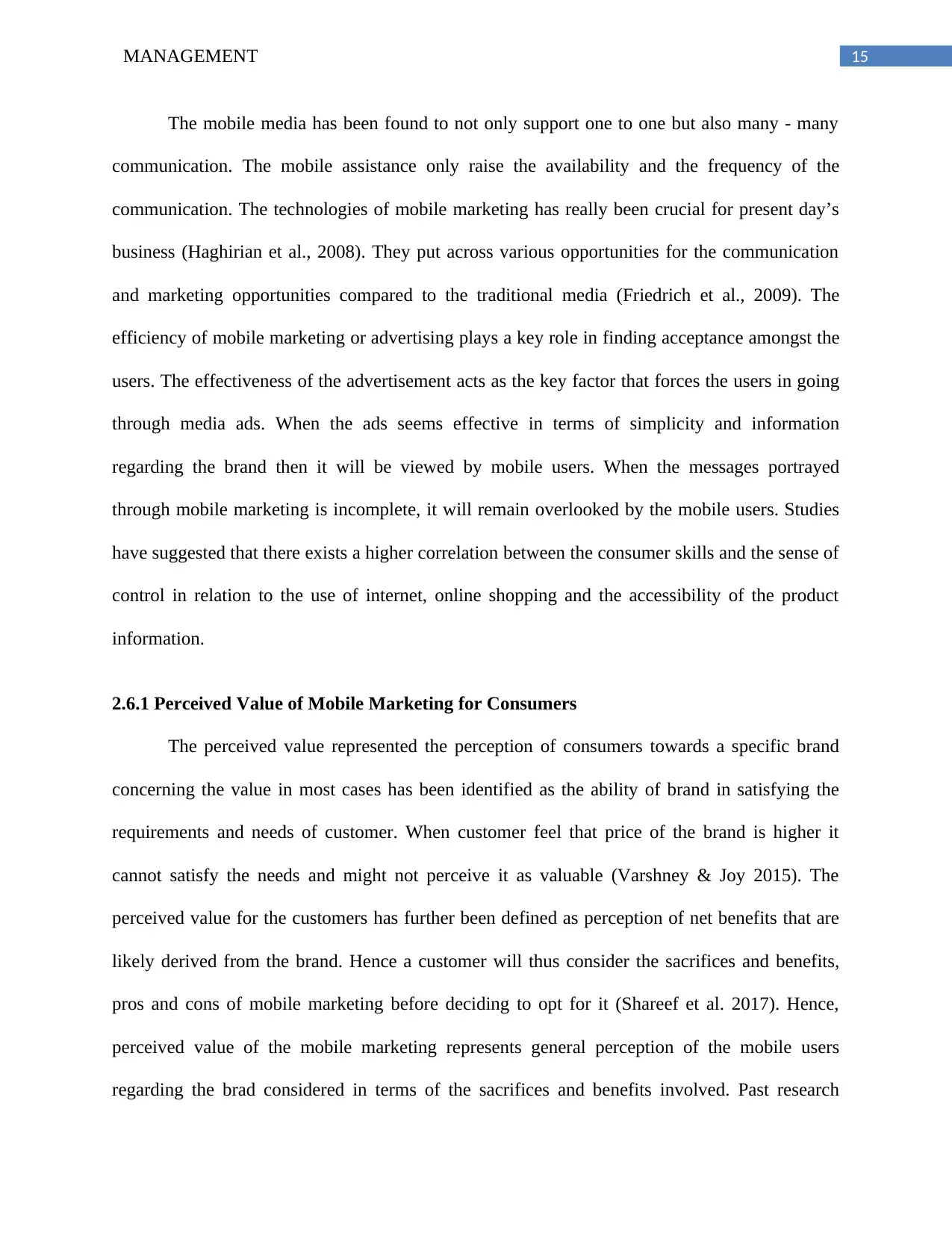
15MANAGEMENT
The mobile media has been found to not only support one to one but also many - many
communication. The mobile assistance only raise the availability and the frequency of the
communication. The technologies of mobile marketing has really been crucial for present day’s
business (Haghirian et al., 2008). They put across various opportunities for the communication
and marketing opportunities compared to the traditional media (Friedrich et al., 2009). The
efficiency of mobile marketing or advertising plays a key role in finding acceptance amongst the
users. The effectiveness of the advertisement acts as the key factor that forces the users in going
through media ads. When the ads seems effective in terms of simplicity and information
regarding the brand then it will be viewed by mobile users. When the messages portrayed
through mobile marketing is incomplete, it will remain overlooked by the mobile users. Studies
have suggested that there exists a higher correlation between the consumer skills and the sense of
control in relation to the use of internet, online shopping and the accessibility of the product
information.
2.6.1 Perceived Value of Mobile Marketing for Consumers
The perceived value represented the perception of consumers towards a specific brand
concerning the value in most cases has been identified as the ability of brand in satisfying the
requirements and needs of customer. When customer feel that price of the brand is higher it
cannot satisfy the needs and might not perceive it as valuable (Varshney & Joy 2015). The
perceived value for the customers has further been defined as perception of net benefits that are
likely derived from the brand. Hence a customer will thus consider the sacrifices and benefits,
pros and cons of mobile marketing before deciding to opt for it (Shareef et al. 2017). Hence,
perceived value of the mobile marketing represents general perception of the mobile users
regarding the brad considered in terms of the sacrifices and benefits involved. Past research
The mobile media has been found to not only support one to one but also many - many
communication. The mobile assistance only raise the availability and the frequency of the
communication. The technologies of mobile marketing has really been crucial for present day’s
business (Haghirian et al., 2008). They put across various opportunities for the communication
and marketing opportunities compared to the traditional media (Friedrich et al., 2009). The
efficiency of mobile marketing or advertising plays a key role in finding acceptance amongst the
users. The effectiveness of the advertisement acts as the key factor that forces the users in going
through media ads. When the ads seems effective in terms of simplicity and information
regarding the brand then it will be viewed by mobile users. When the messages portrayed
through mobile marketing is incomplete, it will remain overlooked by the mobile users. Studies
have suggested that there exists a higher correlation between the consumer skills and the sense of
control in relation to the use of internet, online shopping and the accessibility of the product
information.
2.6.1 Perceived Value of Mobile Marketing for Consumers
The perceived value represented the perception of consumers towards a specific brand
concerning the value in most cases has been identified as the ability of brand in satisfying the
requirements and needs of customer. When customer feel that price of the brand is higher it
cannot satisfy the needs and might not perceive it as valuable (Varshney & Joy 2015). The
perceived value for the customers has further been defined as perception of net benefits that are
likely derived from the brand. Hence a customer will thus consider the sacrifices and benefits,
pros and cons of mobile marketing before deciding to opt for it (Shareef et al. 2017). Hence,
perceived value of the mobile marketing represents general perception of the mobile users
regarding the brad considered in terms of the sacrifices and benefits involved. Past research
Secure Best Marks with AI Grader
Need help grading? Try our AI Grader for instant feedback on your assignments.
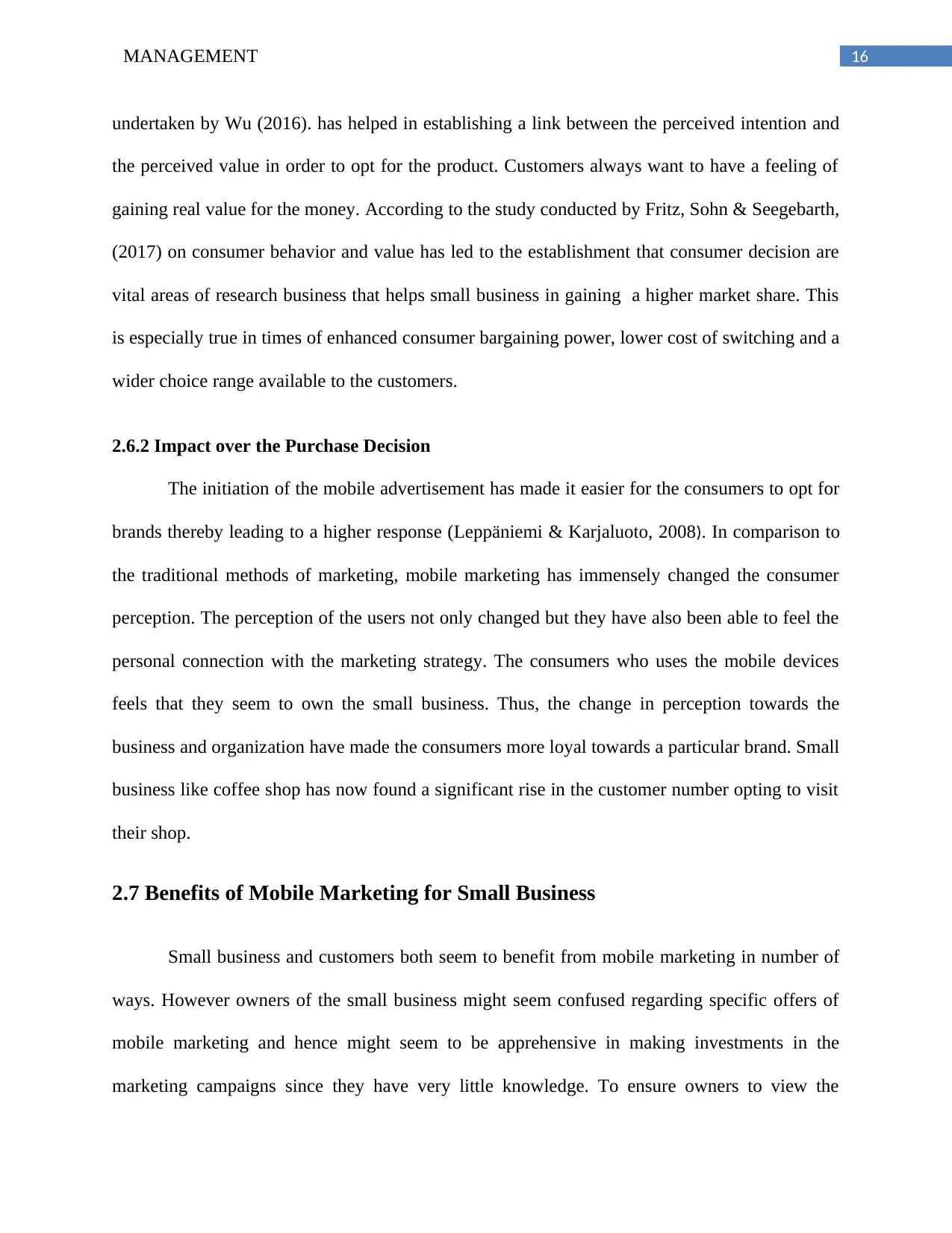
16MANAGEMENT
undertaken by Wu (2016). has helped in establishing a link between the perceived intention and
the perceived value in order to opt for the product. Customers always want to have a feeling of
gaining real value for the money. According to the study conducted by Fritz, Sohn & Seegebarth,
(2017) on consumer behavior and value has led to the establishment that consumer decision are
vital areas of research business that helps small business in gaining a higher market share. This
is especially true in times of enhanced consumer bargaining power, lower cost of switching and a
wider choice range available to the customers.
2.6.2 Impact over the Purchase Decision
The initiation of the mobile advertisement has made it easier for the consumers to opt for
brands thereby leading to a higher response (Leppäniemi & Karjaluoto, 2008). In comparison to
the traditional methods of marketing, mobile marketing has immensely changed the consumer
perception. The perception of the users not only changed but they have also been able to feel the
personal connection with the marketing strategy. The consumers who uses the mobile devices
feels that they seem to own the small business. Thus, the change in perception towards the
business and organization have made the consumers more loyal towards a particular brand. Small
business like coffee shop has now found a significant rise in the customer number opting to visit
their shop.
2.7 Benefits of Mobile Marketing for Small Business
Small business and customers both seem to benefit from mobile marketing in number of
ways. However owners of the small business might seem confused regarding specific offers of
mobile marketing and hence might seem to be apprehensive in making investments in the
marketing campaigns since they have very little knowledge. To ensure owners to view the
undertaken by Wu (2016). has helped in establishing a link between the perceived intention and
the perceived value in order to opt for the product. Customers always want to have a feeling of
gaining real value for the money. According to the study conducted by Fritz, Sohn & Seegebarth,
(2017) on consumer behavior and value has led to the establishment that consumer decision are
vital areas of research business that helps small business in gaining a higher market share. This
is especially true in times of enhanced consumer bargaining power, lower cost of switching and a
wider choice range available to the customers.
2.6.2 Impact over the Purchase Decision
The initiation of the mobile advertisement has made it easier for the consumers to opt for
brands thereby leading to a higher response (Leppäniemi & Karjaluoto, 2008). In comparison to
the traditional methods of marketing, mobile marketing has immensely changed the consumer
perception. The perception of the users not only changed but they have also been able to feel the
personal connection with the marketing strategy. The consumers who uses the mobile devices
feels that they seem to own the small business. Thus, the change in perception towards the
business and organization have made the consumers more loyal towards a particular brand. Small
business like coffee shop has now found a significant rise in the customer number opting to visit
their shop.
2.7 Benefits of Mobile Marketing for Small Business
Small business and customers both seem to benefit from mobile marketing in number of
ways. However owners of the small business might seem confused regarding specific offers of
mobile marketing and hence might seem to be apprehensive in making investments in the
marketing campaigns since they have very little knowledge. To ensure owners to view the

17MANAGEMENT
opportunity clearly, this section of the research study portrays some of the benefits of mobile
marketing.
Benefits of Adopting Mobile App: Leaders of small business has identified the huge
potential of the mobile marketing. In the year, overall earnings of the organizations via
the mobile platform has been close to $429 billion. Customers were found to spend
billions of dollars via the devices (Alnawas & Aburub, 2016). In a growing mobile
landscape, things seem a bit crowded for the newcomers. For staking the claim, the app
chosen by small business needed to leverage the available technology in a manner that
helped in resolving the customer pain points. The traditional theory of marketing has
solely been based on impressions and conversion (Xu, Frankwick & Ramirez, 2016). It is
a general norm that more the people remain exposed to the business, the more will be the
tendency of purchasing from them. Therefore, to create a longer term relationship with
the audience it is vital to remember the human factor. However, the technology that is
made available for the app dependent mobile marketing enables the companies in
connecting to the customers at an increasingly personal level. An average consumer
remains active on their mobiles for over three hours on daily basis (Ghose, A., & Han,
2014). Hence, the use of the apps adds an entire new kind of specification to such
interaction. An app is able to predict when the customer is actually hungry and therefore
send them instant coupon and thereby use the GPS in order to guide them to the location.
Benefits of Artificial Intelligence Integration in Mobile Device: In today’s time every
smart phone is able to use cloud based software for generating program. The programs
has been able to process huge information within seconds. It is no longer hard to have
apps that sends push notification just twenty minutes before breakfast. The photo of a hot
opportunity clearly, this section of the research study portrays some of the benefits of mobile
marketing.
Benefits of Adopting Mobile App: Leaders of small business has identified the huge
potential of the mobile marketing. In the year, overall earnings of the organizations via
the mobile platform has been close to $429 billion. Customers were found to spend
billions of dollars via the devices (Alnawas & Aburub, 2016). In a growing mobile
landscape, things seem a bit crowded for the newcomers. For staking the claim, the app
chosen by small business needed to leverage the available technology in a manner that
helped in resolving the customer pain points. The traditional theory of marketing has
solely been based on impressions and conversion (Xu, Frankwick & Ramirez, 2016). It is
a general norm that more the people remain exposed to the business, the more will be the
tendency of purchasing from them. Therefore, to create a longer term relationship with
the audience it is vital to remember the human factor. However, the technology that is
made available for the app dependent mobile marketing enables the companies in
connecting to the customers at an increasingly personal level. An average consumer
remains active on their mobiles for over three hours on daily basis (Ghose, A., & Han,
2014). Hence, the use of the apps adds an entire new kind of specification to such
interaction. An app is able to predict when the customer is actually hungry and therefore
send them instant coupon and thereby use the GPS in order to guide them to the location.
Benefits of Artificial Intelligence Integration in Mobile Device: In today’s time every
smart phone is able to use cloud based software for generating program. The programs
has been able to process huge information within seconds. It is no longer hard to have
apps that sends push notification just twenty minutes before breakfast. The photo of a hot
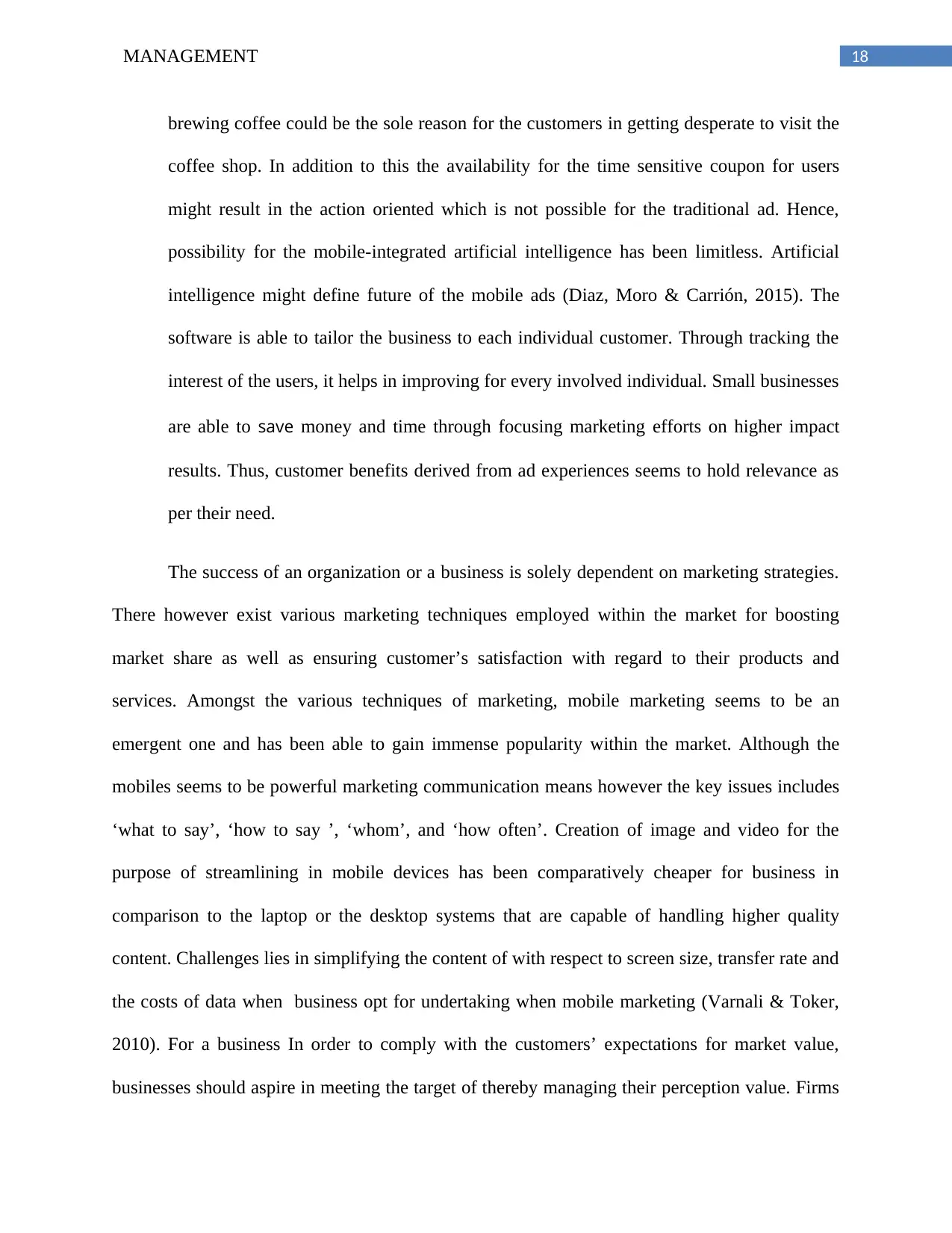
18MANAGEMENT
brewing coffee could be the sole reason for the customers in getting desperate to visit the
coffee shop. In addition to this the availability for the time sensitive coupon for users
might result in the action oriented which is not possible for the traditional ad. Hence,
possibility for the mobile-integrated artificial intelligence has been limitless. Artificial
intelligence might define future of the mobile ads (Diaz, Moro & Carrión, 2015). The
software is able to tailor the business to each individual customer. Through tracking the
interest of the users, it helps in improving for every involved individual. Small businesses
are able to save money and time through focusing marketing efforts on higher impact
results. Thus, customer benefits derived from ad experiences seems to hold relevance as
per their need.
The success of an organization or a business is solely dependent on marketing strategies.
There however exist various marketing techniques employed within the market for boosting
market share as well as ensuring customer’s satisfaction with regard to their products and
services. Amongst the various techniques of marketing, mobile marketing seems to be an
emergent one and has been able to gain immense popularity within the market. Although the
mobiles seems to be powerful marketing communication means however the key issues includes
‘what to say’, ‘how to say ’, ‘whom’, and ‘how often’. Creation of image and video for the
purpose of streamlining in mobile devices has been comparatively cheaper for business in
comparison to the laptop or the desktop systems that are capable of handling higher quality
content. Challenges lies in simplifying the content of with respect to screen size, transfer rate and
the costs of data when business opt for undertaking when mobile marketing (Varnali & Toker,
2010). For a business In order to comply with the customers’ expectations for market value,
businesses should aspire in meeting the target of thereby managing their perception value. Firms
brewing coffee could be the sole reason for the customers in getting desperate to visit the
coffee shop. In addition to this the availability for the time sensitive coupon for users
might result in the action oriented which is not possible for the traditional ad. Hence,
possibility for the mobile-integrated artificial intelligence has been limitless. Artificial
intelligence might define future of the mobile ads (Diaz, Moro & Carrión, 2015). The
software is able to tailor the business to each individual customer. Through tracking the
interest of the users, it helps in improving for every involved individual. Small businesses
are able to save money and time through focusing marketing efforts on higher impact
results. Thus, customer benefits derived from ad experiences seems to hold relevance as
per their need.
The success of an organization or a business is solely dependent on marketing strategies.
There however exist various marketing techniques employed within the market for boosting
market share as well as ensuring customer’s satisfaction with regard to their products and
services. Amongst the various techniques of marketing, mobile marketing seems to be an
emergent one and has been able to gain immense popularity within the market. Although the
mobiles seems to be powerful marketing communication means however the key issues includes
‘what to say’, ‘how to say ’, ‘whom’, and ‘how often’. Creation of image and video for the
purpose of streamlining in mobile devices has been comparatively cheaper for business in
comparison to the laptop or the desktop systems that are capable of handling higher quality
content. Challenges lies in simplifying the content of with respect to screen size, transfer rate and
the costs of data when business opt for undertaking when mobile marketing (Varnali & Toker,
2010). For a business In order to comply with the customers’ expectations for market value,
businesses should aspire in meeting the target of thereby managing their perception value. Firms
Paraphrase This Document
Need a fresh take? Get an instant paraphrase of this document with our AI Paraphraser
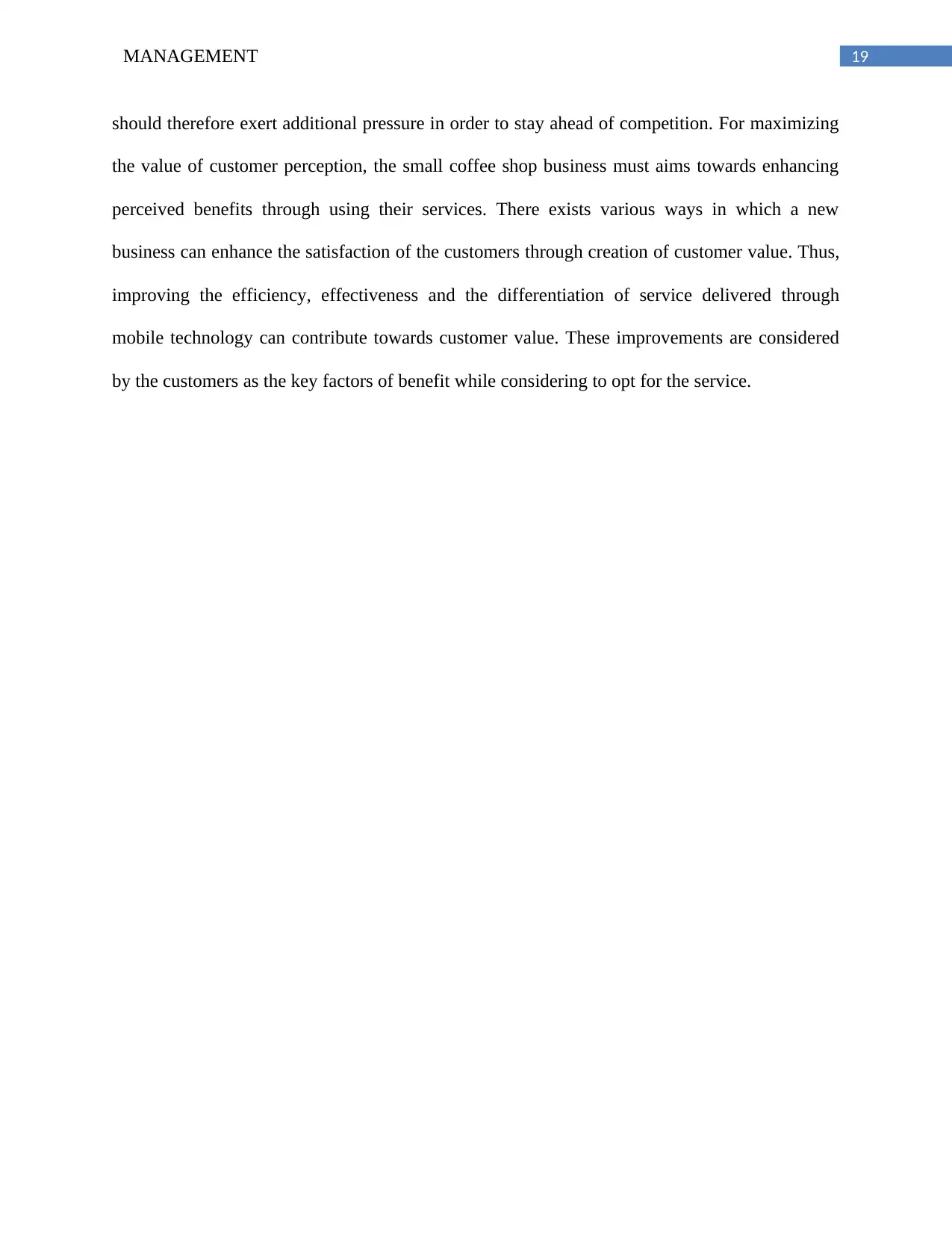
19MANAGEMENT
should therefore exert additional pressure in order to stay ahead of competition. For maximizing
the value of customer perception, the small coffee shop business must aims towards enhancing
perceived benefits through using their services. There exists various ways in which a new
business can enhance the satisfaction of the customers through creation of customer value. Thus,
improving the efficiency, effectiveness and the differentiation of service delivered through
mobile technology can contribute towards customer value. These improvements are considered
by the customers as the key factors of benefit while considering to opt for the service.
should therefore exert additional pressure in order to stay ahead of competition. For maximizing
the value of customer perception, the small coffee shop business must aims towards enhancing
perceived benefits through using their services. There exists various ways in which a new
business can enhance the satisfaction of the customers through creation of customer value. Thus,
improving the efficiency, effectiveness and the differentiation of service delivered through
mobile technology can contribute towards customer value. These improvements are considered
by the customers as the key factors of benefit while considering to opt for the service.
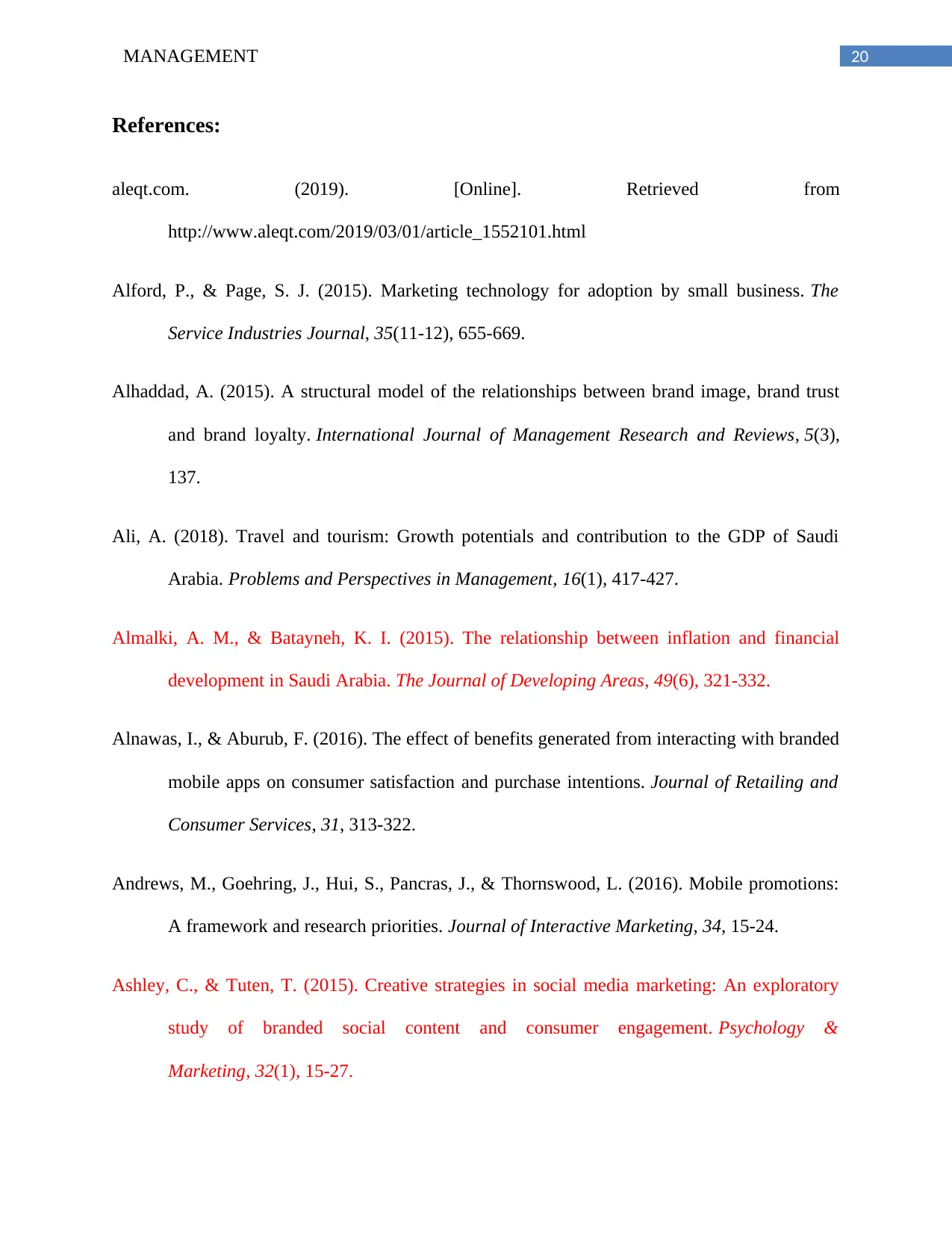
20MANAGEMENT
References:
aleqt.com. (2019). [Online]. Retrieved from
http://www.aleqt.com/2019/03/01/article_1552101.html
Alford, P., & Page, S. J. (2015). Marketing technology for adoption by small business. The
Service Industries Journal, 35(11-12), 655-669.
Alhaddad, A. (2015). A structural model of the relationships between brand image, brand trust
and brand loyalty. International Journal of Management Research and Reviews, 5(3),
137.
Ali, A. (2018). Travel and tourism: Growth potentials and contribution to the GDP of Saudi
Arabia. Problems and Perspectives in Management, 16(1), 417-427.
Almalki, A. M., & Batayneh, K. I. (2015). The relationship between inflation and financial
development in Saudi Arabia. The Journal of Developing Areas, 49(6), 321-332.
Alnawas, I., & Aburub, F. (2016). The effect of benefits generated from interacting with branded
mobile apps on consumer satisfaction and purchase intentions. Journal of Retailing and
Consumer Services, 31, 313-322.
Andrews, M., Goehring, J., Hui, S., Pancras, J., & Thornswood, L. (2016). Mobile promotions:
A framework and research priorities. Journal of Interactive Marketing, 34, 15-24.
Ashley, C., & Tuten, T. (2015). Creative strategies in social media marketing: An exploratory
study of branded social content and consumer engagement. Psychology &
Marketing, 32(1), 15-27.
References:
aleqt.com. (2019). [Online]. Retrieved from
http://www.aleqt.com/2019/03/01/article_1552101.html
Alford, P., & Page, S. J. (2015). Marketing technology for adoption by small business. The
Service Industries Journal, 35(11-12), 655-669.
Alhaddad, A. (2015). A structural model of the relationships between brand image, brand trust
and brand loyalty. International Journal of Management Research and Reviews, 5(3),
137.
Ali, A. (2018). Travel and tourism: Growth potentials and contribution to the GDP of Saudi
Arabia. Problems and Perspectives in Management, 16(1), 417-427.
Almalki, A. M., & Batayneh, K. I. (2015). The relationship between inflation and financial
development in Saudi Arabia. The Journal of Developing Areas, 49(6), 321-332.
Alnawas, I., & Aburub, F. (2016). The effect of benefits generated from interacting with branded
mobile apps on consumer satisfaction and purchase intentions. Journal of Retailing and
Consumer Services, 31, 313-322.
Andrews, M., Goehring, J., Hui, S., Pancras, J., & Thornswood, L. (2016). Mobile promotions:
A framework and research priorities. Journal of Interactive Marketing, 34, 15-24.
Ashley, C., & Tuten, T. (2015). Creative strategies in social media marketing: An exploratory
study of branded social content and consumer engagement. Psychology &
Marketing, 32(1), 15-27.
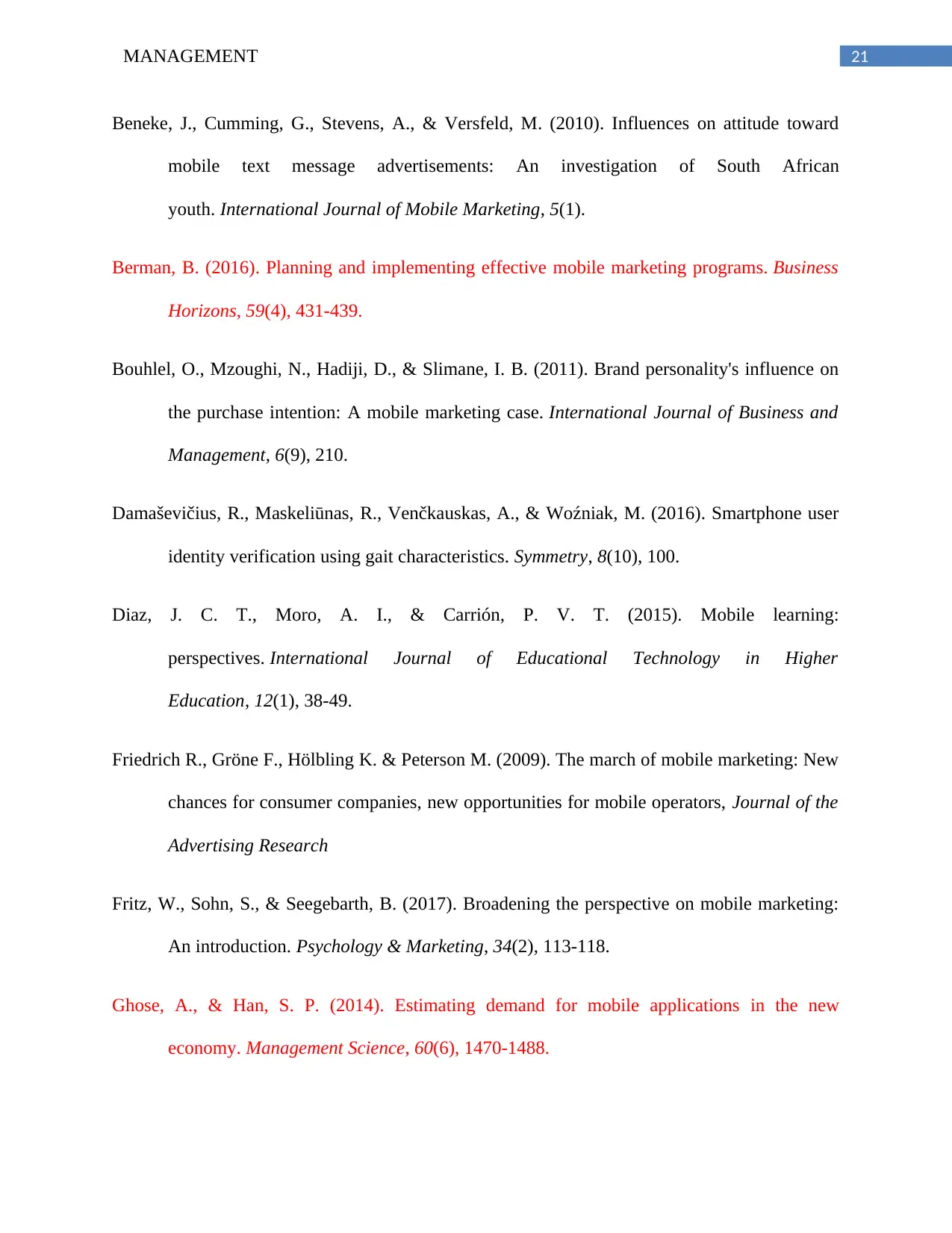
21MANAGEMENT
Beneke, J., Cumming, G., Stevens, A., & Versfeld, M. (2010). Influences on attitude toward
mobile text message advertisements: An investigation of South African
youth. International Journal of Mobile Marketing, 5(1).
Berman, B. (2016). Planning and implementing effective mobile marketing programs. Business
Horizons, 59(4), 431-439.
Bouhlel, O., Mzoughi, N., Hadiji, D., & Slimane, I. B. (2011). Brand personality's influence on
the purchase intention: A mobile marketing case. International Journal of Business and
Management, 6(9), 210.
Damaševičius, R., Maskeliūnas, R., Venčkauskas, A., & Woźniak, M. (2016). Smartphone user
identity verification using gait characteristics. Symmetry, 8(10), 100.
Diaz, J. C. T., Moro, A. I., & Carrión, P. V. T. (2015). Mobile learning:
perspectives. International Journal of Educational Technology in Higher
Education, 12(1), 38-49.
Friedrich R., Gröne F., Hölbling K. & Peterson M. (2009). The march of mobile marketing: New
chances for consumer companies, new opportunities for mobile operators, Journal of the
Advertising Research
Fritz, W., Sohn, S., & Seegebarth, B. (2017). Broadening the perspective on mobile marketing:
An introduction. Psychology & Marketing, 34(2), 113-118.
Ghose, A., & Han, S. P. (2014). Estimating demand for mobile applications in the new
economy. Management Science, 60(6), 1470-1488.
Beneke, J., Cumming, G., Stevens, A., & Versfeld, M. (2010). Influences on attitude toward
mobile text message advertisements: An investigation of South African
youth. International Journal of Mobile Marketing, 5(1).
Berman, B. (2016). Planning and implementing effective mobile marketing programs. Business
Horizons, 59(4), 431-439.
Bouhlel, O., Mzoughi, N., Hadiji, D., & Slimane, I. B. (2011). Brand personality's influence on
the purchase intention: A mobile marketing case. International Journal of Business and
Management, 6(9), 210.
Damaševičius, R., Maskeliūnas, R., Venčkauskas, A., & Woźniak, M. (2016). Smartphone user
identity verification using gait characteristics. Symmetry, 8(10), 100.
Diaz, J. C. T., Moro, A. I., & Carrión, P. V. T. (2015). Mobile learning:
perspectives. International Journal of Educational Technology in Higher
Education, 12(1), 38-49.
Friedrich R., Gröne F., Hölbling K. & Peterson M. (2009). The march of mobile marketing: New
chances for consumer companies, new opportunities for mobile operators, Journal of the
Advertising Research
Fritz, W., Sohn, S., & Seegebarth, B. (2017). Broadening the perspective on mobile marketing:
An introduction. Psychology & Marketing, 34(2), 113-118.
Ghose, A., & Han, S. P. (2014). Estimating demand for mobile applications in the new
economy. Management Science, 60(6), 1470-1488.
Secure Best Marks with AI Grader
Need help grading? Try our AI Grader for instant feedback on your assignments.

22MANAGEMENT
Grewal, D., Bart, Y., Spann, M. & Zubcsek, P. P. (2015). Mobile Advertising: A Framework and
Research Agenda. Journal of Interactive Marketing, Forthcoming.
Haghirian P., Madlberger M. & Inoue A. (2008). “Mobile advertising in different stages of
development: Across-country comparison of consumer attitudes”, in: 41st Hawaii
International Conference on System Sciences.
Hopkins J &Turner J (2012). Go mobile: location-based marketing, apps, mobile optimized ad
campaigns, 2D codes and other mobile strategies to grow your business. Wiley, Hoboken
Jehanzeb, K., Rasheed, A., & Rasheed, M. F. (2013). Organizational commitment and turnover
intentions: Impact of employee’s training in private sector of Saudi Arabia. International
Journal of Business and Management, 8(8), 79-90.
Lamberton, C., & Stephen, A. T. (2016). A thematic exploration of digital, social media, and
mobile marketing: Research evolution from 2000 to 2015 and an agenda for future
inquiry. Journal of Marketing, 80(6), 146-172.
Leppäniemi, M. and Karjaluoto, H., 2008. Mobile marketing: From marketing strategy to mobile
marketing campaign implementation. International Journal of Mobile Marketing, 3(1).
Mahboub, A. A., & Ahmed, H. E. (2017). The effect of oil price shocks on the Saudi
manufacturing sector. Economics, 5(3), 230-238.
Makki, E., & Chang, L. C. (2015). Understanding the effects of social media and mobile usage
on e-commerce: an exploratory study in Saudi Arabia. International management
review, 11(2), 98.
Grewal, D., Bart, Y., Spann, M. & Zubcsek, P. P. (2015). Mobile Advertising: A Framework and
Research Agenda. Journal of Interactive Marketing, Forthcoming.
Haghirian P., Madlberger M. & Inoue A. (2008). “Mobile advertising in different stages of
development: Across-country comparison of consumer attitudes”, in: 41st Hawaii
International Conference on System Sciences.
Hopkins J &Turner J (2012). Go mobile: location-based marketing, apps, mobile optimized ad
campaigns, 2D codes and other mobile strategies to grow your business. Wiley, Hoboken
Jehanzeb, K., Rasheed, A., & Rasheed, M. F. (2013). Organizational commitment and turnover
intentions: Impact of employee’s training in private sector of Saudi Arabia. International
Journal of Business and Management, 8(8), 79-90.
Lamberton, C., & Stephen, A. T. (2016). A thematic exploration of digital, social media, and
mobile marketing: Research evolution from 2000 to 2015 and an agenda for future
inquiry. Journal of Marketing, 80(6), 146-172.
Leppäniemi, M. and Karjaluoto, H., 2008. Mobile marketing: From marketing strategy to mobile
marketing campaign implementation. International Journal of Mobile Marketing, 3(1).
Mahboub, A. A., & Ahmed, H. E. (2017). The effect of oil price shocks on the Saudi
manufacturing sector. Economics, 5(3), 230-238.
Makki, E., & Chang, L. C. (2015). Understanding the effects of social media and mobile usage
on e-commerce: an exploratory study in Saudi Arabia. International management
review, 11(2), 98.
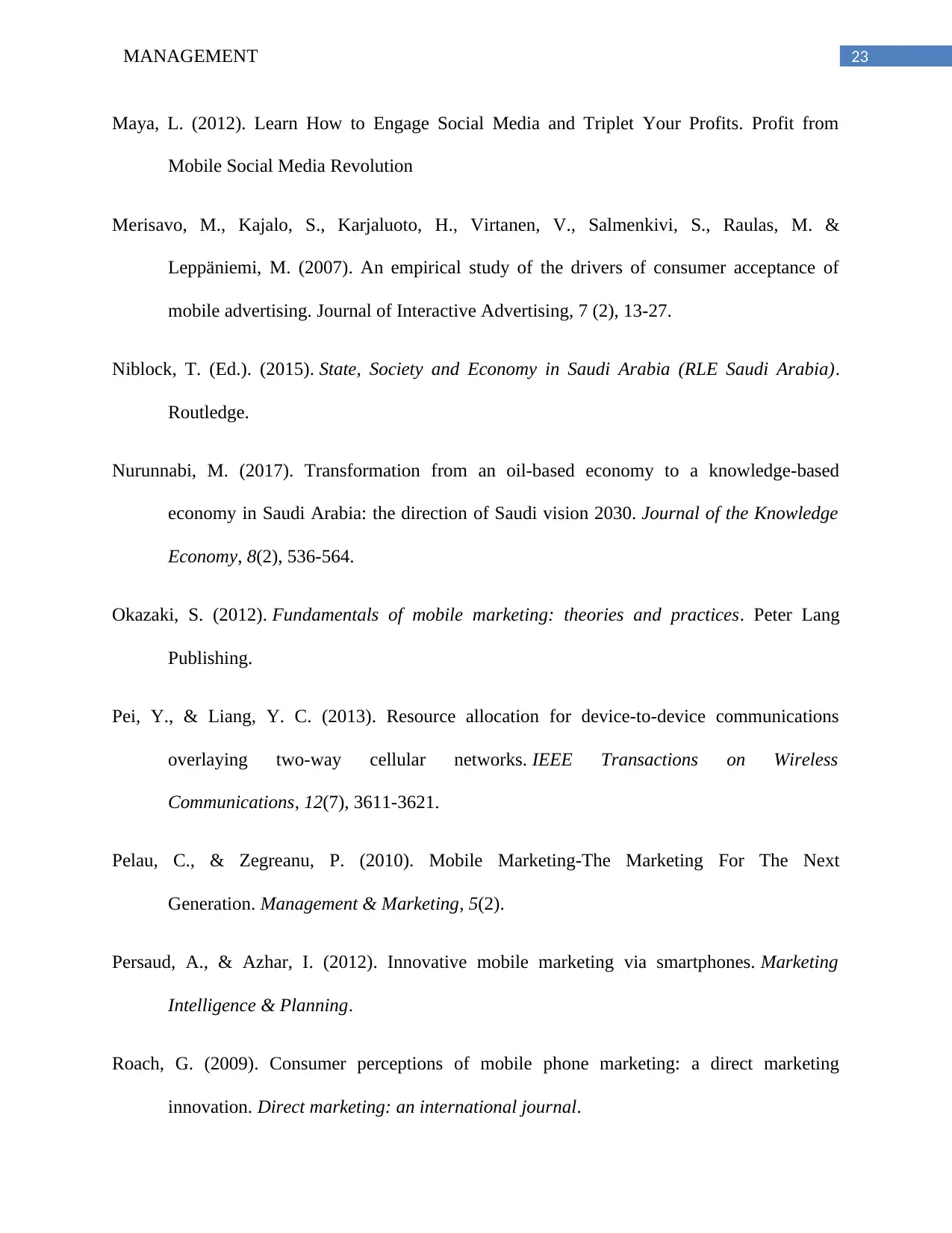
23MANAGEMENT
Maya, L. (2012). Learn How to Engage Social Media and Triplet Your Profits. Profit from
Mobile Social Media Revolution
Merisavo, M., Kajalo, S., Karjaluoto, H., Virtanen, V., Salmenkivi, S., Raulas, M. &
Leppäniemi, M. (2007). An empirical study of the drivers of consumer acceptance of
mobile advertising. Journal of Interactive Advertising, 7 (2), 13-27.
Niblock, T. (Ed.). (2015). State, Society and Economy in Saudi Arabia (RLE Saudi Arabia).
Routledge.
Nurunnabi, M. (2017). Transformation from an oil-based economy to a knowledge-based
economy in Saudi Arabia: the direction of Saudi vision 2030. Journal of the Knowledge
Economy, 8(2), 536-564.
Okazaki, S. (2012). Fundamentals of mobile marketing: theories and practices. Peter Lang
Publishing.
Pei, Y., & Liang, Y. C. (2013). Resource allocation for device-to-device communications
overlaying two-way cellular networks. IEEE Transactions on Wireless
Communications, 12(7), 3611-3621.
Pelau, C., & Zegreanu, P. (2010). Mobile Marketing-The Marketing For The Next
Generation. Management & Marketing, 5(2).
Persaud, A., & Azhar, I. (2012). Innovative mobile marketing via smartphones. Marketing
Intelligence & Planning.
Roach, G. (2009). Consumer perceptions of mobile phone marketing: a direct marketing
innovation. Direct marketing: an international journal.
Maya, L. (2012). Learn How to Engage Social Media and Triplet Your Profits. Profit from
Mobile Social Media Revolution
Merisavo, M., Kajalo, S., Karjaluoto, H., Virtanen, V., Salmenkivi, S., Raulas, M. &
Leppäniemi, M. (2007). An empirical study of the drivers of consumer acceptance of
mobile advertising. Journal of Interactive Advertising, 7 (2), 13-27.
Niblock, T. (Ed.). (2015). State, Society and Economy in Saudi Arabia (RLE Saudi Arabia).
Routledge.
Nurunnabi, M. (2017). Transformation from an oil-based economy to a knowledge-based
economy in Saudi Arabia: the direction of Saudi vision 2030. Journal of the Knowledge
Economy, 8(2), 536-564.
Okazaki, S. (2012). Fundamentals of mobile marketing: theories and practices. Peter Lang
Publishing.
Pei, Y., & Liang, Y. C. (2013). Resource allocation for device-to-device communications
overlaying two-way cellular networks. IEEE Transactions on Wireless
Communications, 12(7), 3611-3621.
Pelau, C., & Zegreanu, P. (2010). Mobile Marketing-The Marketing For The Next
Generation. Management & Marketing, 5(2).
Persaud, A., & Azhar, I. (2012). Innovative mobile marketing via smartphones. Marketing
Intelligence & Planning.
Roach, G. (2009). Consumer perceptions of mobile phone marketing: a direct marketing
innovation. Direct marketing: an international journal.

24MANAGEMENT
Rowles, D. (2017). Mobile marketing: how mobile technology is revolutionizing marketing,
communications and advertising. Kogan Page Publishers.
Shankar, V. & Sridhar, B..(2009). Mobile Marketing: A Synthesis and Prognosis. Journal of
Interactive Marketing, 23, 118-129
Shareef, M. A., Dwivedi, Y. K., & Kumar, V. (2016). Mobile marketing channel. In Mobile
Marketing Channel (pp. 25-45). Springer, Cham.
Shareef, M. A., Dwivedi, Y. K., Kumar, V., & Kumar, U. (2017). Content design of
advertisement for consumer exposure: Mobile marketing through short messaging
service. International Journal of Information Management, 37(4), 257-268.
Shareef, M. A., Dwivedi, Y. K., Kumar, V., & Kumar, U. (2017). Content design of
advertisement for consumer exposure: Mobile marketing through short messaging
service. International Journal of Information Management, 37(4), 257-268.
Smutkupt, P., Krairit, D., & Khang, D. B. (2012). Mobile marketing and consumer perceptions
of brand equity. Asia Pacific Journal of Marketing and Logistics.
statista.com, 2020. [Online]. Retrieved from https://www.statista.com/statistics/277125/share-of-
website-traffic-coming-from-mobile-devices/
Ström, R., Vendel, M., & Bredican, J. (2014). Mobile marketing: A literature review on its value
for consumers and retailers. Journal of Retailing and Consumer Services, 21(6), 1001-
1012.
Sugarhood, P., Wherton, J., Procter, R., Hinder, S., & Greenhalgh, T. (2014). Technology as
system innovation: a key informant interview study of the application of the diffusion of
Rowles, D. (2017). Mobile marketing: how mobile technology is revolutionizing marketing,
communications and advertising. Kogan Page Publishers.
Shankar, V. & Sridhar, B..(2009). Mobile Marketing: A Synthesis and Prognosis. Journal of
Interactive Marketing, 23, 118-129
Shareef, M. A., Dwivedi, Y. K., & Kumar, V. (2016). Mobile marketing channel. In Mobile
Marketing Channel (pp. 25-45). Springer, Cham.
Shareef, M. A., Dwivedi, Y. K., Kumar, V., & Kumar, U. (2017). Content design of
advertisement for consumer exposure: Mobile marketing through short messaging
service. International Journal of Information Management, 37(4), 257-268.
Shareef, M. A., Dwivedi, Y. K., Kumar, V., & Kumar, U. (2017). Content design of
advertisement for consumer exposure: Mobile marketing through short messaging
service. International Journal of Information Management, 37(4), 257-268.
Smutkupt, P., Krairit, D., & Khang, D. B. (2012). Mobile marketing and consumer perceptions
of brand equity. Asia Pacific Journal of Marketing and Logistics.
statista.com, 2020. [Online]. Retrieved from https://www.statista.com/statistics/277125/share-of-
website-traffic-coming-from-mobile-devices/
Ström, R., Vendel, M., & Bredican, J. (2014). Mobile marketing: A literature review on its value
for consumers and retailers. Journal of Retailing and Consumer Services, 21(6), 1001-
1012.
Sugarhood, P., Wherton, J., Procter, R., Hinder, S., & Greenhalgh, T. (2014). Technology as
system innovation: a key informant interview study of the application of the diffusion of
Paraphrase This Document
Need a fresh take? Get an instant paraphrase of this document with our AI Paraphraser
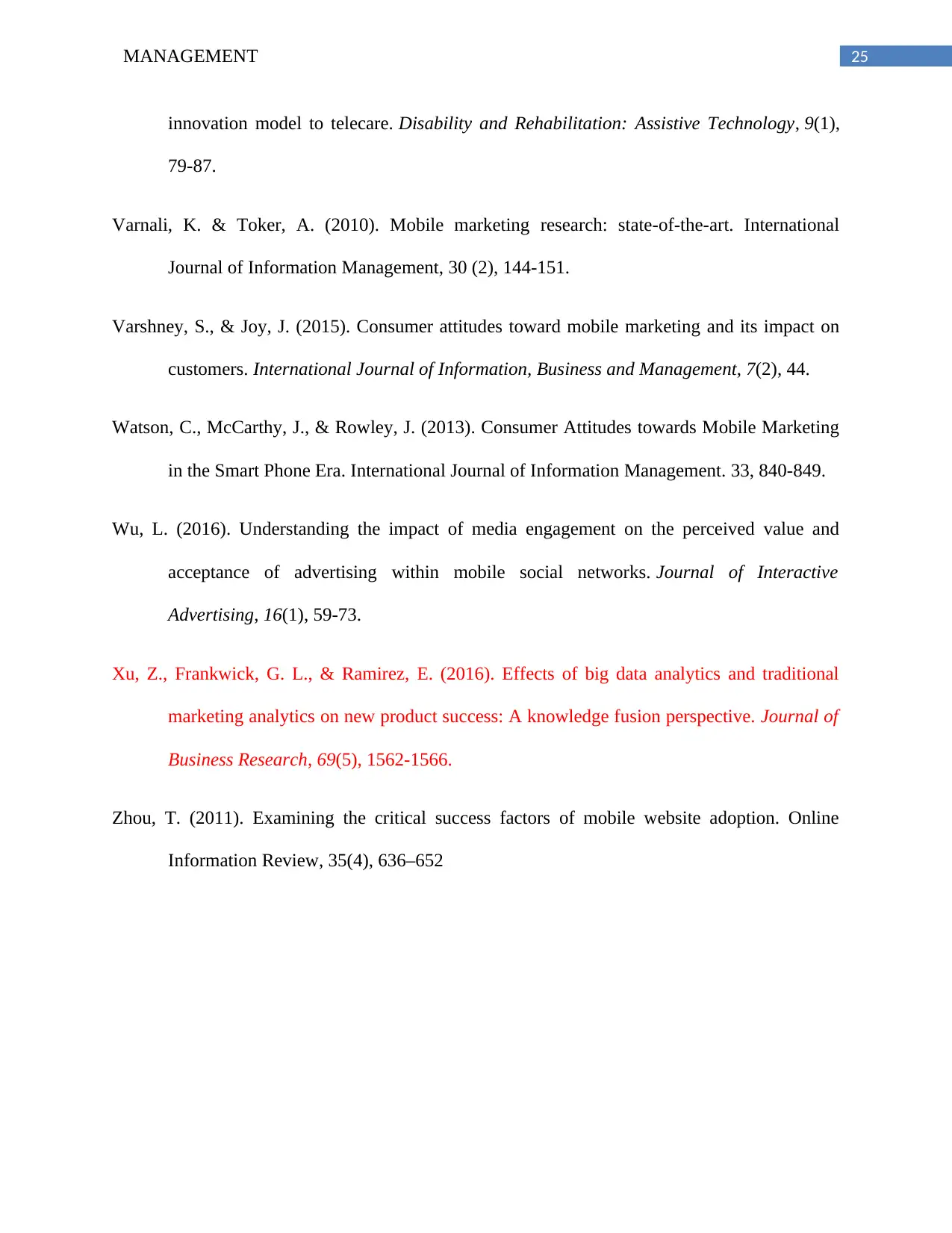
25MANAGEMENT
innovation model to telecare. Disability and Rehabilitation: Assistive Technology, 9(1),
79-87.
Varnali, K. & Toker, A. (2010). Mobile marketing research: state-of-the-art. International
Journal of Information Management, 30 (2), 144-151.
Varshney, S., & Joy, J. (2015). Consumer attitudes toward mobile marketing and its impact on
customers. International Journal of Information, Business and Management, 7(2), 44.
Watson, C., McCarthy, J., & Rowley, J. (2013). Consumer Attitudes towards Mobile Marketing
in the Smart Phone Era. International Journal of Information Management. 33, 840-849.
Wu, L. (2016). Understanding the impact of media engagement on the perceived value and
acceptance of advertising within mobile social networks. Journal of Interactive
Advertising, 16(1), 59-73.
Xu, Z., Frankwick, G. L., & Ramirez, E. (2016). Effects of big data analytics and traditional
marketing analytics on new product success: A knowledge fusion perspective. Journal of
Business Research, 69(5), 1562-1566.
Zhou, T. (2011). Examining the critical success factors of mobile website adoption. Online
Information Review, 35(4), 636–652
innovation model to telecare. Disability and Rehabilitation: Assistive Technology, 9(1),
79-87.
Varnali, K. & Toker, A. (2010). Mobile marketing research: state-of-the-art. International
Journal of Information Management, 30 (2), 144-151.
Varshney, S., & Joy, J. (2015). Consumer attitudes toward mobile marketing and its impact on
customers. International Journal of Information, Business and Management, 7(2), 44.
Watson, C., McCarthy, J., & Rowley, J. (2013). Consumer Attitudes towards Mobile Marketing
in the Smart Phone Era. International Journal of Information Management. 33, 840-849.
Wu, L. (2016). Understanding the impact of media engagement on the perceived value and
acceptance of advertising within mobile social networks. Journal of Interactive
Advertising, 16(1), 59-73.
Xu, Z., Frankwick, G. L., & Ramirez, E. (2016). Effects of big data analytics and traditional
marketing analytics on new product success: A knowledge fusion perspective. Journal of
Business Research, 69(5), 1562-1566.
Zhou, T. (2011). Examining the critical success factors of mobile website adoption. Online
Information Review, 35(4), 636–652
1 out of 26
Your All-in-One AI-Powered Toolkit for Academic Success.
+13062052269
info@desklib.com
Available 24*7 on WhatsApp / Email
![[object Object]](/_next/static/media/star-bottom.7253800d.svg)
Unlock your academic potential
© 2024 | Zucol Services PVT LTD | All rights reserved.





